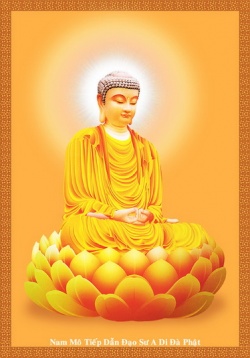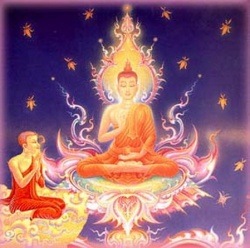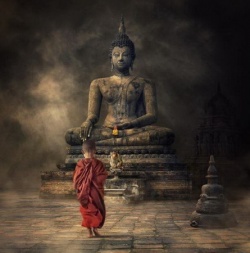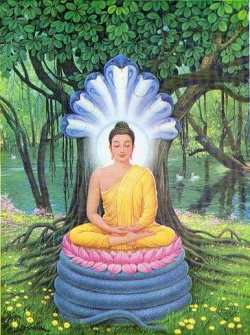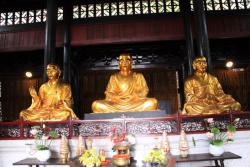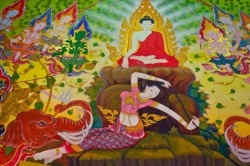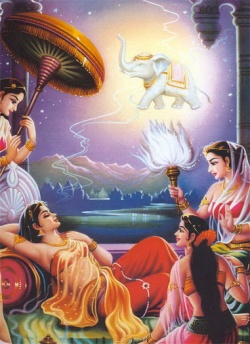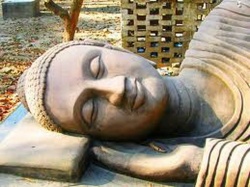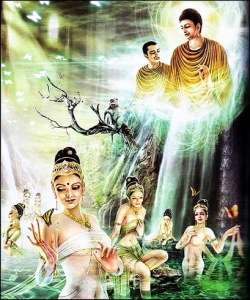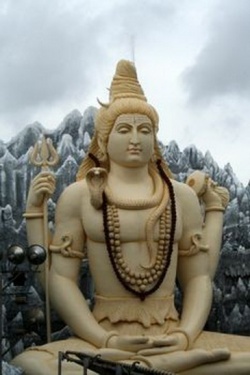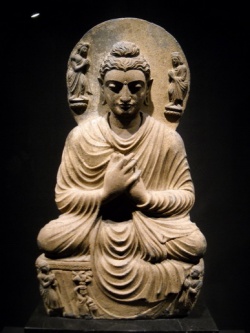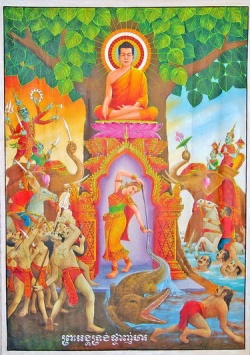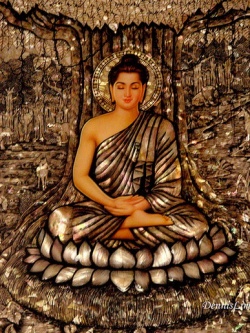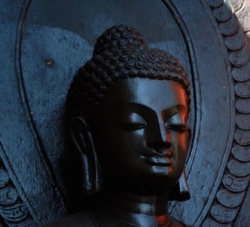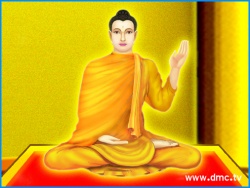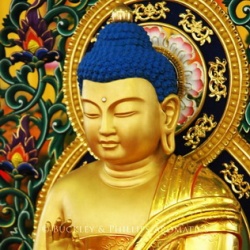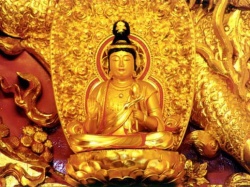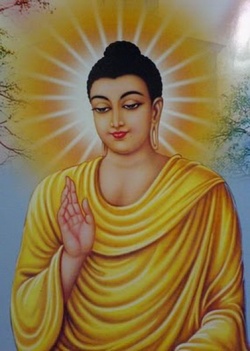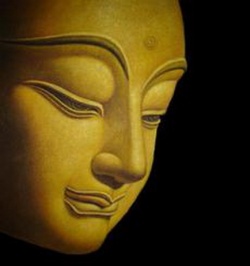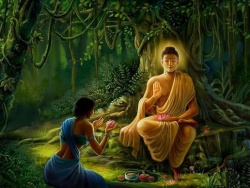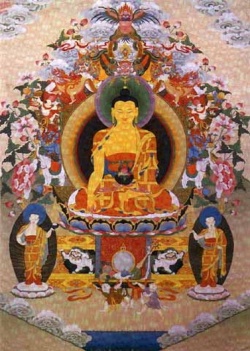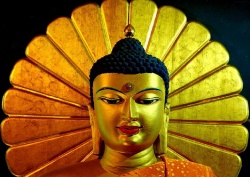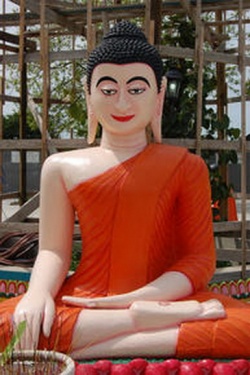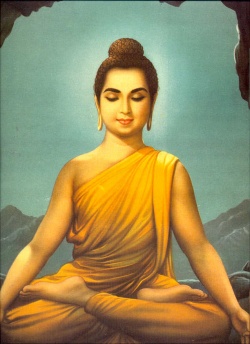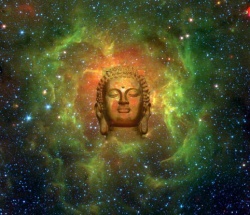Difference between revisions of "Buddhism and Spinoza by Joseph B. Yesselman"
(Created page with "thumb|250px| <poem> 1. Unless otherwise noted all material herein is taken from The Teaching Company's "Buddhism"; 12 cassettes, 2 course guide bo...") |
m (Text replacement - "]]]" to "]])") |
||
| (3 intermediate revisions by 3 users not shown) | |||
| Line 1: | Line 1: | ||
[[File:Spinoza.jpg|thumb|250px|]] | [[File:Spinoza.jpg|thumb|250px|]] | ||
| − | < | + | '''Notes'''<br/> |
| − | 1. Unless otherwise noted all material herein is taken from The Teaching Company's | + | 1. Unless otherwise noted all material herein is taken from The [[Teaching]] Company's "[[Buddhism]] "; 12 cassettes, 2 course guide [[books]] (CG1, CG2), and 2 transcript [[books]] (TB1 & TB2); all authored by Prof. [[Malcolm David Eckel]]. © 2001 The [[Teaching]] Company Limited Partnership |
| − | + | Only parts of seven Lectures (Lectures 1 to 6, & 12.) of a total of 24 Lectures are included herein. I unrestrainedly recommend your study of The [[Teaching]] Company's "[[Buddhism]] " for the complete 24 Lectures | |
| − | 2. Symbols: | + | 2. [[Symbols]]: |
| − | + | Unless noted, all comments are from The [[Teaching]] Company's "[[Buddhism]] " or Prof. [[Eckel]]. | |
| − | + | ||
| − | + | :{JBY opinion—or where, I think, Spinozism concurs or differs with [[Buddhism]] ; or, Spinozism's [[world]] view.} | |
| − | + | :R<comment from Robison and Johnson>R:Page Number | |
| + | :S<comment from Strong>S:Page Number | ||
[[File:PhatAdiDa9.jpg|thumb|250px|]] | [[File:PhatAdiDa9.jpg|thumb|250px|]] | ||
| − | 3. My purpose is to show the insights of Buddhism and also where Spinoza's insights would, | + | 3. My {{Wiki|purpose}} is to show the [[insights]] of [[Buddhism]] and also where [[Spinoza's]] [[insights]] would, |
| − | |||
| − | |||
| − | |||
| − | + | I believe, concur or differ. I use the [[word]] differ instead of disagree because disagree implies one or the other is wrong. Whereas differ implies they are both correct and useful for the '[[world]] view' held. These different '[[world]] [[views]]' are [[caused]] by differences of {{Wiki|culture}}, economic [[development]], technological [[development]], {{Wiki|environmental}} [[conditions]], climate, personal disposition, etc., etc., etc. On the whole, I believe {{Wiki|Spinoza}} puts into {{Wiki|modern}} [[rational]] [[language]] the [[insights]] of [[Buddhism]] and avoids unfamiliar [[parables]] and unfamilar catch-words such as '[[Emptiness]] ', 'No {[[permanent]]} [[self]] ", and '[[Nirvana]] '. See Spinozism for some concurrences and some differences. Again, over the centuries, like any other [[religion]] , [[Buddhism]] has changed and evolved as [[conditions]] change, L12:II. | |
| − | |||
| − | + | ==Lecture One== | |
| − | + | ===What is [[Buddhism]] ?=== | |
| − | [[ | + | CG1:3 |
| − | |||
| − | + | '''Scope''': | |
| − | + | In its 2,500-year history, from the [[time]] of the [[Buddha]] to the {{Wiki|present}} day, [[Buddhism]] has grown from a tiny [[religious]] {{Wiki|community}} in northern [[India]] into a {{Wiki|movement}} that now spans the {{Wiki|globe}}. It has shaped the [[development]] of {{Wiki|civilization}} in [[India]] and {{Wiki|Southeast Asia}}; has had major influence on the {{Wiki|civilizations}} of [[China]] , [[Tibet]] , [[Korea]] , and [[Japan]] ; and today has become a major part of the multi-[[religious]] [[world]] of {{Wiki|Europe}} and [[North America]]. Through all of its many changes, what is [[Buddhism]] , and how should we study it? These lectures will explore the [[Buddhist]] [[tradition]] as the unfolding of a story. It is the story of the [[Buddha]] himself and the story of generations of [[people]] who have used the model of the [[Buddha]] 's [[life]] to shape not only their [[own]] [[lives]] but the {{Wiki|societies}} in which they live. | |
| − | + | [[File:Tiantai0045.jpg|thumb|250px|]] | |
| − | + | '''Outline''': | |
| − | + | I. [[Buddhism]] originated in northern [[India]] around 500 B.C.E.. | |
| + | :A. The [[tradition]] gets its [[name]] from a man who was known by his followers as the [[Buddha]] , or the "[[Awakened]] {[[enlightened]] } One." | ||
| − | + | ::1. He was born into a princely [[family]] in a region of northern [[India]] that is now in southern [[Nepal]] . | |
| + | ::2. He often is depicted sitting very serenely, with his feet crossed in front of him and his hands folded in his lap. He is the very picture of [[calm]] and [[Wikipedia:contemplation|contemplation]] . This is the image that has drawn [[people]] to the [[Buddha]] for many centuries, and it is the one that conveys most explicitly the [[experience]] of his [[awakening]] . | ||
| + | ::3. But the [[Buddha]] did not always sit still in {{Wiki|perfect}} [[Wikipedia:contemplation|contemplation]] . After his [[awakening]] , he got up from his seat and [[taught]] his [[experience]] to others on the roads of northern [[India]] . {[[Spinoza's]] teachings—Ethics, TEI, TTP.} | ||
| + | ::4. The major events of the [[Buddha]] 's [[life]] took place in the [[Madhyadesha]], or the "Middle Region" of the [[Ganges]] Basin. (These sites are still the focus of [[Buddhist]] [[pilgrimage]] today.) | ||
[[File:145-io.jpg|thumb|250px|]] | [[File:145-io.jpg|thumb|250px|]] | ||
| − | + | ::5. To understand the significance of the [[Buddha]] 's [[life]] , we will spend two lectures, right at the beginning of our course, studying the [[religious]] background that made it possible for the [[Buddha]] to have such a strong [[religious]] impact on [[Indian]] {{Wiki|civilization}}. | |
| − | + | ::6. Then we will discuss the three categories, or '[[jewels]]," that are fundamental to [[Buddhist]] [[life]] . We will spend one lecture on the [[life]] of the [[Buddha]] himself; two lectures on his [[teaching]], or [[dharma]] ; one lecture on the [[development]] of the early [[Buddhist]] {{Wiki|community}}; and one lecture on the [[tradition]] of [[Buddhist]] [[art]]. | |
| − | |||
| − | |||
| − | |||
| − | |||
| − | + | CG1:5<br/> | |
| + | II. | ||
| + | :D. When we study the [[teaching]] of the [[Buddha]] , we will see that the diversity of the [[Buddhist]] [[tradition]] is no surprise. | ||
| − | + | ::1. The [[Buddha]] said that everything is [[impermanent]] {perishable}. The [[evolution]] of the [[Buddhist]] [[tradition]] itself exemplifies [[truth]] . | |
| + | ::2. The [[Buddha]] also said that [[nothing]] has any [[permanent]] [[Wikipedia:Identity (social science)|identity]]. (This is the famous [[Buddhist]] [[doctrine]] of "no {[[permanent]]} [[self]] " and {I-thee}.") Momentary [[phenomena]] give the [[illusion]] of continuity {but they are real} , like the moments of flowing [[water]] that make up the current of a [[river]] or the flickers of burning gas that make up the flame of a candle. | ||
[[File:Munk66814 n.jpg|thumb|250px|]] | [[File:Munk66814 n.jpg|thumb|250px|]] | ||
| − | + | ::3. As the [[Buddhist]] [[tradition]] has changed and adapted to new situations and new needs, it sometimes has changed so radically that it is hard to know anymore what makes it "[[Buddhist]] ." | |
| − | CG1:6 | + | CG1:6<br/> |
| − | IV. Finally, I hope the story of the Buddha and the story of Buddhism will in some way become | + | IV. Finally, I {{Wiki|hope}} the story of the [[Buddha]] and the story of [[Buddhism]] will in some way become yours as well. |
| − | + | :A. [[Buddhism]] can be a great challenge to [[people]] who have grown up in the [[Western]] [[world]] and think that [[religion]] has to do with the {{Wiki|worship}} of a single, almighty [[God]] . | |
| + | ::1. The [[Buddha]] did not accept the [[existence]] of a single [[God]] {or any [[god]] (s)} who created the [[world]] . {Deus—Spinoza's G-D is simliar to the [[Buddha]] 's.} | ||
| + | ::2. For that [[matter]] , he did not accept the [[idea]] of a [[permanent]] [[self]] .<br/>Momentary [[phenomena]] give the [[illusion]] of continuity, like the moments of flowing [[water]] that make up the current of a [[river]] or the flickers of burning gas that make up the flame of a candle. | ||
| − | + | :B. Some [[people]] think that [[Buddhism]] is so different from all we know as [[religion]] in the [[Western]] [[world]] that it should be called a [[philosophy]] of [[life]] rather than a {[[scriptural]] {{Wiki|theology}}, [[Miracles]] , etc.} [[religion]]. | |
| + | [[File:Mucalinda Naga.jpg|thumb|250px|]] | ||
| − | + | :C. Either way, [[Buddhism]] challenges us to think in new ways about the [[nature]] of the [[world]] and the possibility of a satisfying and {{Wiki|productive}} [[human]] [[life]] . {Obtaining PcM.} | |
| − | |||
| − | + | Shirley's Book.VII:235—Deus | |
| − | |||
| − | |||
| − | |||
| − | |||
| − | |||
| − | |||
| − | + | :Although {{Wiki|Spinoza}} {and [[Buddhism]] and [[Krishna]]} gives repeated warnings that his "[[Deus]]" is far from the {{Wiki|anthropomorphic}} {{Wiki|conception}} of [[God]] prevalent in the {{Wiki|theology}} of his [[time]] , the reader will find it difficult to bear this constantly in [[mind]]. It is not until E1:XIV:54, that G-D, by [[definition]] {{{Wiki|hypothesis}}}, is shown to be [[identical]] with the [[infinite]], all-inclusive, unique [[substance]], and thereafter it is all too easy to lose [[sight]] of this, as the [[religious]] overtones of the [[word]] "[[God]] " keep asserting themselves. So [[Spinoza's]] frequent use of the [[phrase]] "[[Deus]] sive Natura"— G-D that is Nature—is intended as a salutary corrective. {The terms G-D and [[Nature]] are interchangeable.} For {{Wiki|Spinoza}} G-D is all Being, all [[Reality]] , in all its aspects and in all its [[infinite]] richness. {Isaac B. Singer} | |
| − | |||
| − | |||
| − | Lecture Two | + | ==Lecture Two== |
| − | + | ===[[India]] at the [[Time]] of the [[Buddha]] === | |
| + | CG1:9 | ||
| − | Scope: | + | '''Scope''': |
[[File:Tiantai8 o.jpg|thumb|250px|]] | [[File:Tiantai8 o.jpg|thumb|250px|]] | ||
| − | |||
| − | |||
| − | |||
| − | |||
| − | + | The story of [[Buddhism]] begins in [[India]] in the sixth century B.C.E. with the [[birth]] of [[Siddhartha Gautama]] , the man who was known as the "[[Awakened]] {[[enlightened]] } One," or [[Buddha]] . What was the [[Buddha]] 's [[religious]] and {{Wiki|cultural}} background {Note 3}? What problems did he inherit? Why did he respond to them in the way he did? To answer these questions, we begin our study of [[Buddhism]] by looking back into the [[Vedas]] , the earliest surviving [[scriptures]] of the [[Hindu]] [[tradition]] . The [[Vedas]] tell us about the [[lives]] of [[Indian]] [[sages]] and about an [[Indian]] quest for [[wisdom]] about the [[nature]] of the [[world]] and the [[self]] . When [[Siddhartha Gautama]] "woke up" to the [[truth]] and became the [[Buddha]] , this {{Wiki|distinctive}} [[insight]] made him one of the most {{Wiki|eminent}} and influential of these [[Indian]] [[sages]]. | |
| − | + | CG1:23<br/> | |
| − | + | III. To unpack the [[religious]] history of [[India]] , we turn first to a [[body]] of texts known as the [[Vedas]] . | |
| − | + | :A. These are the most authoritative texts in the [[Hindu]] [[tradition]] and the oldest surviving [[religious]] texts in [[India]] . The earliest hymns in the [[Vedas]] can be dated about 1500-1000 B.C.E.. | |
| + | ::8. One of the last hymns in the {{Wiki|Vedic}} collection posed what I think of as the classic {{Wiki|Vedic}} question. Let me summarize it {[[intellectual]] [[love]] of G-D} so that you can get an [[impression]] of the content of these hymns and [[feel]] the force of the question: | ||
[[File:Mara3321.jpg|thumb|250px|]] | [[File:Mara3321.jpg|thumb|250px|]] | ||
| − | + | :::There was not then either [[Wikipedia:Existence|nonexistence]] or [[existence]] (either asat or sat). There was no sky, and there were no [[heavens]]. What was it that covered everything? What was its [[protection]]? Was there a bottomless depth of waters? | |
| − | + | :::There was neither [[death]] nor [[immortality]] , neither day nor night. The One breathed, though uninspired by [[breath]], by its [[own]] potentiality. Beside it [[nothing]] existed... | |
| − | + | :::Who is there who [[knows]]? Who can tell its origin? Who can tell the source of this creation? The [[gods]] are on this side of the creation. Who [[knows]], then, where it came from and how it came into being? | |
| + | :::Where this creation came from and how it came into being—perhaps the [[highest]] overseer in [[heaven]] [[knows]], or perhaps even he does not know. | ||
| − | + | ::::—Rig [[Veda]] 10.129 <br/>(W. Norman Brown, Man in the [[Universe]] , pp. 29-30). | |
| − | + | :9. You can see that as these early {{Wiki|priests}} composed their hymns around the year 1200 B.C.E., they asked a question about the origin of the [[universe]] . The question took them, in a [[sense]] , beyond the [[gods]] . They wanted to know where everything came from, with {{Wiki|emphasis}} on the [[word]] know. You can also [[feel]] just a suggestion, perhaps, that if they knew {understood} the source of everything, they would know the connection between themselves {as modes} and the rest of the [[cosmos]], and they would be able to control it {and achieve [[peace]] of [[mind]]}. | |
| − | |||
| − | |||
| − | |||
| − | CG1:23 | + | CG1:23<br/> |
| − | III. To unpack the religious history of India, we turn first to a body of texts known as the Vedas. | + | III. To unpack the [[religious]] history of [[India]] , we turn first to a [[body]] of texts known as the [[Vedas]] . |
[[File:Maya dreams0023.jpg|thumb|250px|]] | [[File:Maya dreams0023.jpg|thumb|250px|]] | ||
| − | + | :C. The [[Wikipedia:Upanishads|Upanishads]] tell stories of {{Wiki|priests}} who tried to find {{Wiki|unity}} in the fragmented [[world]] of {{Wiki|Vedic}} [[ritual]] . They focused their speculation in three areas. | |
| − | + | ::1. They identified the [[essence]] of external [[reality]] (or the [[macrocosm]] {the [[universe]] considered as a whole}) as "Being" or "[[Reality]] " (sat - being, is). | |
| − | + | ::2. They identified the [[essence]] of their [[own]] personalities (or the [[microcosm]] {a part of the [[universe]] —a mode}) as "[[Self]] " ([[atman]] ). | |
| − | + | ::3. They identified the [[essence]] of the sacrificial [[ritual]] (or the mesocosm) as [[brahman]] . The [[word]] [[brahman]] originally meant "[[prayer]] ." Here it refers to the [[power]] or [[reality]] that lies behind the [[prayer]] . | |
| − | + | ::4. Once these three {sat = [[atman]] = [[brahman]] } [[essential]] [[realities]] had been identified, the [[Upanishadic]] [[sages]] made a great imaginative leap {{{Wiki|hypothesis}}} and said that all three were aspects of the same thing {G-D}. This leap of the {{Wiki|Vedic}} [[imagination]] resulted in the [[doctrine]] of [[Upanishadic]] {{Wiki|monism}}, the view that all of [[reality]] is one. | |
| − | |||
| − | |||
| − | |||
| − | |||
| − | + | :D. [[Upanishadic]] {{Wiki|monism}} can be expressed positively, as it is in the story of [[Shvetaketu]] and his father, Aruni. | |
| − | + | ::1. One day, Aruni told his son that it was [[time]] for him to take up the [[life]] of a [[student]], and he sent him away to study. When he came back at the age of twenty-four, [[feeling]] swell-headed and [[arrogant]] with all the things he had learned, his father asked him whether he had heard about the "[[principle]] of substitution"—"by which one hears what has not been heard of before and [[thinks]] what has not been [[thought]] of before." [[Shvetaketu]] says that he has not, and Aruni begins to teach him. | |
[[File:14es.jpg|thumb|250px|]] | [[File:14es.jpg|thumb|250px|]] | ||
| − | + | ::2. "It is like this," he said. "By means of one lump of clay {[[substance]]} one would {{Wiki|perceive}} everything made of clay—the [[transformation]] is a [[verbal]] handle , a [[name]] {a mode} —while the [[reality]] is just this: 'Its clay.'" | |
| + | ::3. Then he applies this [[principle]] in a series of [[discourses]] {examples} that [[sound]] to us like [[philosophical]] [[poetry]] : | ||
| − | + | :::The bees, my dear son, prepare [[honey]] by [[gathering]] the [[nectar]] of different [[trees]] and reducing that [[nectar]] to a {{Wiki|unity}}. So, that the [[nectar]] from each different [[tree]] is not able to differentiate: "I am the [[nectar]] of this [[tree]] " and "I am the [[nectar]] of that [[tree]] ." In exactly the same way, my son, when all creatures merge into [[reality]] , they are not {{Wiki|aware}} that "We are merging into [[reality]] ." No {{Wiki|matter}} what they are in this [[world]] —whether they are a [[tiger]]. a [[lion]] , a {{Wiki|wolf}}, a {{Wiki|boar}}, a worm, a moth, a gnat, or a mosquito—they all merge into that [[reality]] . That finest [[essence]] here is the [[self]] of the whole [[world]] . That is [[reality]] ; that is the [[self]]. And that [[art]] thou, [[Shvetaketu]]. {[[Spinoza's]] [[Pantheism]].} | |
| + | ::::—[[Chandogya Upanishad]]<br/>(Robert Ernest [[Hume]], trans., The Thirteen [[Principal]] [[Wikipedia:Upanishads|Upanishads]], 2nd ed. [[Wikipedia:London|London]] : {{Wiki|Oxford}} Univ. Press, 1931:p. 246) | ||
| − | + | CG1:24<br/> | |
| − | + | IV. The [[Buddha]] inherited this [[traditional]] [[Indian]] quest for [[knowledge]] . | |
| − | |||
| − | + | :A. The [[Buddhist]] quest {TEI:[1]} for [[knowledge]] shared three important [[characteristics]] with the quest that was expressed in the [[Wikipedia:Upanishads|Upanishads]]. This [[knowledge]] was intended to bring {{Wiki|unity}} {and [[peace]] of [[mind]]} to three areas of [[life]] : | |
| − | + | [[File:Nanda devatas.JPG|thumb|250px|]] | |
| + | ::1. External [[reality]] . {[[macrocosm]]} {Objectivity—[[Truth]] 1} | ||
| + | ::2. The [[self]] . {[[microcosm]]} {[[Emotions]] —[[Truth]] 2} | ||
| + | ::3. the [[ritual]] or [[symbolic]] practices that united the [[self]] with the [[world]] around it. {mesocosm} | ||
| − | + | :B. This quest for [[knowledge]] was not merely [[intellectual]] . It did not just change the way [[people]] [[thought]] or acted; it changed their very {{Wiki|identities}}. As the text of the [[Brihadaranyaka Upanishad]] says, "If a [[person]] [[knows]] 'I am [[Brahman]] ' in this way, he becomes the whole [[world]] ." {If a [[person]] identifies himself with the eternal [[universe]] he has overcome the {{Wiki|fear}} of [[death]] (and has [[peace]] -of-mind—the function of [[religion]] ) for the eternal [[universe]] is just that—eternal; in Spinozistic terms it is the [[intellectual]] [[love]] of G-D.} | |
| − | [[ | ||
| − | |||
| − | |||
| − | |||
| − | |||
| − | + | :C. Finally, this quest had to do with the challenge of [[overcoming]] {the {{Wiki|fear}} of} [[death]] , as in the story of the encounter between Nachiketas and [[Yama]] (the [[Lord]] of [[Death]] ) in the [[Katha Upanishad]]. | |
| − | |||
| − | |||
| − | + | ::1. When Nachiketas was sent to meet the [[Lord]] of [[Death]] , the [[Lord]] of [[Death]] gave him a well-known [[teaching]] about the [[immortal]] [[soul]] : | |
| − | + | :::The [[wise one]] is not born and does not [[die]]; | |
| − | + | :::He does not come from anywhere; | |
| − | + | :::He does not become anyone. | |
| − | + | :::He is {{Wiki|unborn}}, eternal, primeval, and everlasting, | |
| − | + | :::And he is not killed when the [[body]] is killed. | |
[[File:16-6.jpg|thumb|250px|]] | [[File:16-6.jpg|thumb|250px|]] | ||
| − | + | ::::[[Katha Upanishad]] 1.18<br/>(Patrick Olivelle, trans., [[Wikipedia:Upanishads|Upanishads]], p. 237) | |
| − | |||
| − | + | ::2. With this [[knowledge]] , it was possible for Nachiketas to overcome the [[power]] of [[death]] . | |
| + | :D. We will see that the [[Buddha]] developed a very different [[idea]] of the [[nature]] of the [[self]] , but his goal was similar to the goal of Nachiketas. He wanted to know the [[nature]] of the [[self]] so that he could be released from the [[power]] of [[death]] . {{{Wiki|Spinoza}} 20:18} | ||
| − | + | ==Lecture Three== | |
| − | + | ===The [[Doctrine]] of [[Reincarnation]] === | |
| − | CG1:13 | + | CG1:13 |
| − | + | '''Scope''': | |
| − | |||
| − | |||
| − | Scope: | ||
[[File:194.jpg|thumb|250px|]] | [[File:194.jpg|thumb|250px|]] | ||
| − | Along with the Indian quest for wisdom, the Buddha inherited a basic assumption about the nature of life: Human beings, like all other living creatures, lived not just one life, but came back into this world again and again in a continuous process of death and rebirth. This process is known in India as samsara, or "wandering" from one life to the next. At first glance, the idea of samsara may seem attractive, a chance to enjoy some of the things we missed in this life, but in ancient India, samsara was viewed as a burden. To escape this burden, a person had only two options: to perform {true} good actions (karma) and hope for a better rebirth or to renounce action altogether {see bodhisattva} and bring the cycle of death and rebirth to an end. | + | Along with the [[Indian]] quest for [[wisdom]] , the [[Buddha]] inherited a basic assumption about the [[nature]] of [[life]] : [[Human beings]], like all other living creatures, lived not just one [[life]] , but came back into this [[world]] again and again in a continuous process of [[death]] and [[rebirth]] . This process is known in [[India]] as [[samsara]] , or "wandering" from one [[life]] to the next. At first glance, the [[idea]] of [[samsara]] may seem attractive, a chance to enjoy some of the things we missed in this [[life]] , but in [[ancient]] [[India]] , [[samsara]] was viewed as a [[burden]]. To escape this [[burden]], a [[person]] had only two options: to perform {true} [[good actions]] ([[karma]] ) and {{Wiki|hope}} for a better [[rebirth]] or to {{Wiki|renounce}} [[action]] altogether {see [[bodhisattva]] } and bring the cycle of [[death]] and [[rebirth]] to an end. |
| − | {Cash value of reincarnation: | + | {Cash value of [[reincarnation]] : |
| − | + | :1. The [[belief]] in being [[reborn]] evokes a close, personal, [[loving]] relationship (I-thee) with all [[life]] [[forms]] (the worm you see could be your father [[reborn]]). Also it evokes the [[knowledge]] that everything, animate and [[inanimate]], is made of One Eternal [[Substance]]. | |
| − | + | :2. Pedagogical; it is an incentive to true good {{Wiki|behavior}} in order to be [[reborn]] to a higher station.} | |
| − | CG1:38 & 39 | + | CG1:38 & 39<br/> |
| − | + | III. If [[samsara]] is considered fundamental and is also a [[burden]], how can a [[person]] deal with it? The answer is to follow the law of [[karma]] , the law that governs the passage from one [[life]] to the next. {[[Good and bad]] are [[subjective]] terms; furthermore, in Spinozism there is no 'free-will and therefore no praise-no blame; Spinozism differs with the '[[karma]] ' {{Wiki|hypothesis}}.} | |
| − | III. If samsara is considered fundamental and is also a burden, how can a person deal with it? | ||
| − | |||
[[File:Timthu.jpg|thumb|250px|]] | [[File:Timthu.jpg|thumb|250px|]] | ||
| − | + | :A. The [[word]] [[karma]] means "[[action]]," particularly the kind of [[moral]] [[action]] that affects a person's [[fate]] in a {{Wiki|future}} [[life]] . | |
| + | ::l. According to the law of [[karma]] , [[good actions]] bring a good [[rebirth]] in a {{Wiki|future}} [[life]] , and bad [[actions]] bring a bad [[rebirth]] . {See no free-will.} | ||
| + | ::2. [[Rebirth]] can generally take place in one of six [[realms]] : as a [[god]] , [[demigod]] , [[human being]], [[ghost]] , [[animal]] , or [[spirit]] in [[hell]] . These [[realms]] are vividly displayed in textbooks and paintings to show the punishments that confront evildoers in {{Wiki|future}} [[lives]]. | ||
| − | + | :B. The law of [[karma]] allows two strategies to deal with the problem of [[samsara]] . | |
| + | ::1. According to the ordinary norm (followed by most [[Indian]] [[people]]), a [[person]] attempts to perform good [[action]] to achieve a better [[rebirth]] , such as [[rebirth]] in [[heaven]]. This [[rebirth]] , like all the results of [[karma]], is [[impermanent]] {transitory}. | ||
| + | ::2. According to the [[extraordinary]] norm (followed by only a few [[religious]] specialists), a [[person]] attempts to perform no [[action]] {renunciator violates [[duty]] and is dysfunctional}, either good or bad. The goal is not a better [[rebirth]] , but no [[rebirth]] at all. The [[state]] of no [[rebirth]] , called [[moksha]] ([[liberation]] ) or prinirvana, is [[permanent]]. Once a [[person]] has achieved this [[state]], there is no return in the cycle of [[death]] and [[rebirth]] . | ||
| + | [[File:NatsuYasumi 029.JPG|thumb|250px|]] | ||
| + | :::[[Nirvana]] means '[[cessation of suffering]] ', the goal of [[Buddhist]] [[life]]<br/>{[[Nirvana]] is {{Wiki|equivalent}} to [[Spinoza's]] [[peace]]-of-[[mind]] (acquiescence of [[spirit]] or [[mind]]).} | ||
| − | + | :C. With the two norms come two {{Wiki|distinctive}} styles of [[life]] in [[Indian]] [[society]]. | |
| + | ::1. [[People]] who follow the ordinary norm situate themselves in a network of duties and responsibilities. They are mothers or fathers, [[teachers]] or students, {{Wiki|priests}} or [[kings]], and they are [[bound]] by the {{Wiki|rules}} that govern each of these {{Wiki|social}} roles. | ||
| + | ::2. [[People]] who follow the [[extraordinary]] norm "{{Wiki|renounce}}" these duties and give up their established roles in [[Indian]] [[society]]. The renunciants (sannyasls or bhiikshus and [[bhikshunis]]) have few possessions, often beg for their [[food]] , and live [[lives]] of deliberate [[simplicity]] to escape the network of [[karma]] that ties them in the cycle of [[samsara]] . | ||
| − | + | :D. When Sldhartha [[Gautama]] left the palace and became a wandering [[ascetic]] {to find [[enlightenment]] }, he chose to follow the [[extraordinary]] norm in the {{Wiki|hope}} of freeing himself from the cycle of [[death]] and [[rebirth]] . | |
| − | + | [[File:OriginalBuddha.jpg|thumb|250px|]] | |
| − | |||
| − | |||
| − | |||
| − | |||
| − | [[File: | ||
| − | |||
| − | |||
| − | |||
| − | |||
| − | |||
| − | |||
| − | + | From W. Norman Brown's "Man in the [[Universe]] "; ISBN: 0520001850; Page 39. | |
| + | :The [[Wikipedia:Bhagavad Gita|Bhagavad Gita]] draws heavily upon the [[Wikipedia:Upanishads|Upanishads]] and the [[Vedas]] and some other kinds of [[thinking]] as well, which are not clearly identifiable. It is not consistent in its viewpoint, but [[knows]] and uses {{Wiki|monistic}} [[ideas]], [[dualistic]] [[ideas]], {{Wiki|theistic}} [[ideas]]. It accepts the [[doctrine]] of [[rebirth]] and the effect of one's acts in determining the [[conditions]] of [[rebirth]] . It condemns [[desire]] and teaches [[renunciation]] in the [[name]] of [[God]] {G-D}. [[Release]] from [[rebirth]] may be obtained through the performance of [[deeds]] without [[attachment]] to the results of the [[deeds]], that is through the performance of them selflessly, without any [[emotional]] accompaniment, merely because one is doing his [[duty]] {[[virtue]] }. Higher than this way to {{Wiki|salvation}} is the way of [[knowledge]] , more difficult to achieve—only the rare [[person]] can expect to succeed through it {[[intellectual]] [[love]] of G-D}. But the most feasible way is that of [[loving devotion]] ([[bhakti]] ) to [[God]] {G-D}. This is available to all, not merely to the ironwilled [[devotee]] of [[duty]] or to the superintellectual [[metaphysician]] , but to the lowly, the unsophisticated, the [[people]] of modest [[intelligence]]. Those who practice such [[devotion]] [[Krishna]] {G-D} will accept. The simple [[heart]] is enough. By means of [[devotion]] one can gain the fullest [[knowledge]] , can know G-D, can win to Him. Such a one, in fact, has a special advantage. "I am the same to all [[beings]]," says [[Krishna]], "there is no one either hateful to me or dear; but those who adore me with [[loving devotion]], they are in me and I too in them". | ||
| − | + | ==Lecture Four== | |
| − | [[ | + | ===The Story of the [[Buddha]] === |
| − | |||
| − | |||
| − | |||
| − | |||
CG1:16 | CG1:16 | ||
| − | + | '''Scope''': | |
| − | |||
| − | + | {{Wiki|Historians}} generally agree that [[Siddhartha Gautama]] was born in a princely [[family]] in northern [[India]] about the year 566 B.C.E. As a young man, he gave up [[life]] in the palace and set out to escape the cycle of [[death]] and [[rebirth]] . After several difficult years of study and practice, he "woke up." not only to the [[cause]] of [[suffering]] but to its final [[cessation]] . He then wandered the roads of [[India]] , [[gathering]] together a group of [[disciples]] and establishing a pattern of [[discipline]] for the [[Buddhist]] {{Wiki|community}}. Finally, at about the age of eighty, he lay down and passed gently from the cycle of [[death]] and [[rebirth]] . With the simple events of the [[Buddha]] 's [[life]] as a guide, [[Buddhists]] have developed a rich [[tradition]] of stories and {{Wiki|legends}} that tell us not only how they have understood the founder of their [[tradition]] , but how they have built [[lives]] of [[wisdom]] and freedom for themselves. | |
| − | Historians generally agree that Siddhartha Gautama was born in a princely family in northern India about the year 566 B.C.E. As a young man, he gave up life in the palace and set out to escape the cycle of death and rebirth. After several difficult years of study and practice, he "woke up." not only to the cause of suffering but to its final cessation. He then wandered the roads of India, gathering together a group of disciples and establishing a pattern of discipline for the Buddhist community. Finally, at about the age of eighty, he lay down and passed gently from the cycle of death and rebirth. With the simple events of the Buddha's life as a guide, Buddhists have developed a rich tradition of stories and legends that tell us not only how they have understood the founder of their tradition, but how they have built lives of wisdom and freedom for themselves. | ||
| − | Book I:3 - Spinoza's "On the Improvement of the Understanding"—Way to wisdom | + | [[Book]] I:3 - [[Spinoza's]] "On the Improvement of the Understanding"—Way to [[wisdom]] . |
| − | |||
| − | + | [[Spinoza's]] quest for [[enlightenment]] is {{Wiki|equivalent}} to The [[Buddha]] 's quest. | |
| + | [[File:00buddha513.jpg|thumb|250px|]] | ||
| + | :[1] (1:1) After [[experience]] had [[taught]] me that all the usual surroundings of {{Wiki|social}} [[life]] are vain and futile; [[seeing]] that none of the [[objects]] of my {{Wiki|fears}} contained in themselves anything either good or bad {[[subjective]] terms}, except in so far as the [[mind]] is affected by them, I finally resolved to inquire whether there might be some real good {G-D} having [[power]] to {{Wiki|communicate}} itself, which would affect the [[mind]] singly, to the exclusion of all else: whether, in fact, there might be anything of which the discovery and [[attainment]] would enable me to enjoy continuous, supreme, and unending [[happiness]] {better °PcM}. | ||
| − | + | :[3] (3:1) I therefore [[debated]] whether it would not be possible to arrive at the new [[principle]] {Foundation Rock}, or at any rate at a {{Wiki|certainty}} concerning its [[existence]], without changing the conduct and usual plan of my [[life]] ; with this end in view I made many efforts, but in vain. (3:2) For the ordinary surroundings of [[life]] which are esteemed by men (as their [[actions]] testify) to be the [[highest]] good, may be classed under the three heads—Riches, [[Fame]] , and the [[Pleasures]] of [[Sense]] : with these three the [[mind]] is so absorbed that it has little [[power]] to reflect on any different good. | |
| − | |||
| − | |||
| − | Lecture Five | + | ==Lecture Five== |
| − | + | ===All {Most} is [[Suffering]] === | |
| − | {See | + | CG1:16 |
| + | {See [[definition]] of '[[suffering]] '. Important.} | ||
| − | Scope: | + | '''Scope''': |
| − | Buddhist tradition tells us that the Buddha rose from the seat of his awakening and walked to a deer park in Sarnath, outside the city of Banaras, where he gave his first sermon. This event is called the first "turning of the wheel of dharma [teaching]." Accounts of the Buddha's teaching begin with the simple claim that "All is suffering." People who come to the Buddhist tradition for the first time often interpret this to mean that the Buddha was pessimistic and devalued human life. Buddhists say that he was not pessimistic but realistic. To see the world through Buddhist eyes, the first and most important step is to understand how this simple claim about suffering leads not to pessimism but to a realistic assessment {knowing or attributing to G-D the chain of natural causes and their natural effects and the knowledge that things could not come to pass different than they are} of life's difficulties and to a sense of liberation and peace {of mind, nirvana} | + | [[Buddhist]] [[tradition]] tells us that the [[Buddha]] rose from the seat of his [[awakening]] and walked to a [[deer park]] in [[Sarnath]] , outside the city of [[Banaras]], where he gave his [[first sermon]]. This event is called the first "turning of the [[wheel]] of [[dharma]] ([[teaching]])." Accounts of the [[Buddha]] 's [[teaching]] begin with the simple claim that "All is [[suffering]] ." [[People]] who come to the [[Buddhist]] [[tradition]] for the first [[time]] often interpret this to mean that the [[Buddha]] was {{Wiki|pessimistic}} and devalued [[human]] [[life]] . [[Buddhists]] say that he was not {{Wiki|pessimistic}} but {{Wiki|realistic}}. To see the [[world]] through [[Buddhist]] [[eyes]] , the first and most important step is to understand how this simple claim about [[suffering]] leads not to [[pessimism]] but to a {{Wiki|realistic}} assessment {[[knowing]] or attributing to G-D the chain of natural [[causes]] and their natural effects and the [[knowledge]] that things could not come to pass different than they are} of [[life]] 's difficulties and to a [[sense]] of [[liberation]] and [[peace]] {of [[mind]], [[nirvana]] }. |
| − | |||
| − | |||
| − | |||
| − | |||
| − | + | ====Lecture 5 - CG1:5:21 & 22.==== | |
| − | + | II. In the "[[Discourse]] on the Turning of the [[Wheel]] of [[Dharma]] (Dhammacakappavattana [[Sutta]] ), the [[traditional]] summary of the [[Buddha]] 's [[first sermon]], the [[Buddha]] 's [[teaching]] is summarized in [[Four Noble Truths]] . | |
| − | |||
| − | |||
| − | |||
| − | + | :A. The [[Four Noble Truths]] are: | |
| − | + | ::1. The [[truth]] of [[suffering]] ([[dukkha]] ) {[[caused]] by [[nothing]] being permanent;but moments of [[emotion]] are real} | |
| − | + | ::2. The [[truth]] of the [[arising]] of [[suffering]] {due to [[ignorance]] and harmful [[desires]] } | |
| − | + | ::3. The [[truth]] of the [[cessation of suffering]] (also known as [[nirvana]] {[[peace]] of [[mind]]}) | |
| + | ::4. The [[Noble]] [[Truth]] of the [[path]] that leads to the [[cessation of suffering]] . | ||
| + | -------------- | ||
| + | S>1.6 The [[Four Noble Truths]] can be stated as follows: | ||
| + | [[File:10d2fd63.jpg|thumb|250px|]] | ||
| + | :1. that [[life]] in all the [[realms]] of [[rebirth]] is, by [[definition]], ultimately unsatisfactory, [[suffering]] ([[duhkha]]) | ||
| + | :2. that there is a [[reason]] for this [[suffering]] , an origination ([[samudaya]]) of it, which is connected to our ongoing [[desire]] , a [[thirst]] that we cannot assuage, a [[clinging]] to possessions, to persons, to [[life]] itself | ||
| + | :3. that there is, however, such a thing as freedom from or the [[cessation]] ([[nirodha]]) of this unsatisfactory [[state]], this [[suffering]] , which will come with the rooting out (rather than the mere assuagement) of that on- going [[thirst]] {[[Spinoza's]] view L5:V:A2—notice that [[suffering]] does not have to do with [[sorrow]] and [[pain]], but with loss of [[peace]] of [[mind]]; worrying about the [[sorrow]] and [[pain]]. Remedy.} | ||
| + | :4. that the way to do this is to practice the so-called [[Noble Eightfold Path]] | ||
| − | + | S<This [[Path]] (marga) is the same as the [[realization]] of the [[Middle Way]] , between the extremes of indulgence and asceticism, and it is for this [[reason]] that the [[Buddha]] often preached the [[Middle Way]] along with the [[Four Noble Truths]] .>S:32 | |
| + | ---------------------- | ||
| + | III. The [[truth]] of [[suffering]] {loss of [[peace]] of [[mind]]} is expressed in the simple claim that "All is [[suffering]] ." | ||
| − | + | :A. When [[people]] come to the [[Buddhist]] [[tradition]] for the first [[time]] , they often interpret this claim to mean that the [[Buddha]] was {{Wiki|pessimistic}}. Our job is to understand how this simple statement about [[suffering]] leads not to [[pessimism]] but to a [[sense]] of [[liberation]] and [[peace]] . | |
| − | + | :B. [[Traditional]] sources say that "All is [[suffering]] " in one of [[three ways]]. | |
| + | ::1. Dukkhu-[[dukkha]] ([[suffering]] that is obviously [[suffering]] ): some things [[cause]] obvious [[physical]] or [[mental]] [[pain]] {loss of an arm}. | ||
| + | ::2. Viparirnama-[[dukkha]] ([[suffering]] due to change): even the most [[pleasurable]] things [[cause]] [[suffering]] when they begin to change and pass away {beginning to see the arm wither}. | ||
| + | ::3. [[Samkhara]]-[[dukkha]] ([[suffering]] due to [[conditioned]] states):<br/>[[pleasurable]] things can [[cause]] [[pain]] even in the midst of the [[pleasure]], if the [[pleasure]] is based on an [[illusion]] about the [[nature]] of the [[object]] {[[substance]] abuse} or even about the [[nature]] of the [[self]] {excessive [[pride]] or [[self]]-[[confidence]]}. | ||
| + | [[File:024 n.jpg|thumb|250px|]] | ||
| + | :C. These three kinds of [[suffering]] {loss of [[peace]] -of-mind} can be illustrated by creating a [[parable]] about a car. | ||
| + | ::1. A car [[causes]] [[dukkha]] -[[dukkha]] if you drive it into the back of a bus. | ||
| + | ::2. A car [[causes]] viparinama-[[dukkha]] if you're [[attached]] to that car and drive it through a New [[England]] winter and watch it disintegrate in the snow and [[salt]]. | ||
| + | ::3. A car [[causes]] [[samkhara]]-[[dukkha]] if you think there is something in yourself or in the car that will be enhanced by [[attachment]] [being fully invested with all of your [[impermanent]] "I"] to the car. | ||
| − | + | :D. The significance of these three kinds of [[suffering]] {loss of [[peace]] -of-mind} can be explained by relating them to the three *'marks" of [[existence]]. | |
| − | + | ::1. Everything is [[suffering]] . | |
| + | ::2. Everything is [[impermanent]] {transitory}. | ||
| + | ::3. [[Nothing]] has any [[self]] , or "all is no {[[permanent]]} [[self]] " ([[anatta]] ). | ||
| + | -------- | ||
| + | S<3.2 SUFFERING, IMPERMANENCE, AND no {permanent} [[self]] | ||
| − | + | We have already seen (in 1.6) that [[suffering]] , or unsatisfactoriness {loss of [[peace]] of mind} (duhkha, [[Pali]] : [[dukkha]] ) was propounded as the first of the [[Four Noble Truths]] . [[Suffering]] figures also as the first of the three "marks," or "characteristics," of existence along with [[impermanence]] ([[anitya]] , [[Pali]] : [[anicca]] ), and no-[[Self]] , or the absence of a [[Self]] ([[anatman]] , [[Pali]] : [[anatta]] ). These three [[doctrines]] , of course, are closely interdependent. Things are "[[suffering]] ," that is, not finally satisfying, because they are [[impermanent]] : they do not last forever, or even for a moment, but are in a constant process of change; and partly because of this, there can be no [[Self]] , that is, no "abiding ego," no "unchanging me," and consequently no "mine.">S89 | |
| − | + | {For the small {{Wiki|interval}} of [[time]] involved to make a [[judgment]], I can know if I am '[[sorrowful]], 'bored', or '[[happy]] '. Whatever it is, with [[understanding]] I can have [[peace]] -of-mind and thus save [[suffering]] . [[Spinoza's]] Dictum.} | |
| − | + | :S<3.2.1 [[Impermanence]] | |
| + | [[File:17952-medium.jpg|thumb|250px|]] | ||
| + | :Many [[Buddhist texts]] touch on the theme of [[impermanence]] or on the momentariness of the elements of existence, the "[[dharmas]] " that in [[Nikaya]] [[Buddhism]] are the basic constituents of [[reality]] . The full implications of the [[Buddhist]] [[doctrine]] of [[impermanence]] , as we shall see, were not without their [[philosophical]] convolutions, and these were tackled differently by different schools and worked out even more fully in the [[Mahayana]] . At a basic level, however, [[impermanence]] always meant simply that all beings, all things, having arisen, pass away: they die.>S:89, 90 | ||
| + | ------------------ | ||
| + | IV. What do [[Buddhists]] mean when they say that there is no {[[permanent]]} [[self]] ? | ||
| − | + | :A. In [[traditional]] [[Buddhism]] , "no [[self]] " means that no [[permanent]] [[Wikipedia:Identity (social science)|identity]] continues from one [[moment]] to the next. [This is a basic [[doctrinal]] [[assertion]] in the [[Buddhist]] [[tradition]] .] | |
| − | + | :B. This claim poses an obvious problem: If there is no {[[permanent]]} [[self]] , what makes up the [[human]] [[personality]]? | |
| + | ::1. The answer to this question is: the [[personality]] is made up of five "[[aggregates]] " or [[skandhas]] , bundles of momentary [[phenomena]] , beginning with (a) material [[form]] ([[rupa]] ); (b) [[sensations]] ; (c) [[ideas]] {{{Wiki|data}} base}; (d) [[Wikipedia:Volition (psychology)|volition]] {decisions that are made, like a {{Wiki|computer}} does}; and then, finally, (e) [[consciousness]] ([[viññana]]), the [[consciousness]] that observes the flow of this causal {chained} process. | ||
| + | ::2. These five [[aggregates]] are only momentary, but they group together to give the [[illusion]] of [[permanence]], like the flow of a [[river]] or the flame of a candle. | ||
| + | ::{3. See Lecture 5- TB5:79.} | ||
| − | + | :C. If there is no {[[permanent]]} [[self]] , what is [[reborn]]? | |
| − | + | ::l. The answer is the "{{Wiki|stream}}" or "flame" of [[consciousness]] ([[viññana]]). | |
| + | ::2. Because of the causal continuity between moments in the flame. it is possible to say that I am the "same" [[person]] from one [[moment]] to the next {and do [[judge]] my very real-to-me [[emotional]] [[condition]] at any one [[moment]]}. | ||
| + | ::3. But when we look closely at the flame, we realize that it changes every [[moment]], and the [[idea]] that one [[moment]] is the same as another is [[nothing]] but an [[illusion]] . | ||
| − | + | V. Is this view of [[human]] [[life]] {{Wiki|pessimistic}}? | |
| − | + | :A. The [[doctrine]] of "no {[[permanent]]} [[self]] " helps us understand why the [[doctrine]] of [[suffering]] is not as {{Wiki|pessimistic}} as it seems. | |
| + | ::1. From a [[Buddhist]] {{{Wiki|eternity}}} point of view, it is simply {{Wiki|realistic}} to accept that the [[human]] [[personality]] and all of [[reality]] is constantly changing. | ||
| + | ::2. The [[cause]] of [[suffering]] is not the change {[[sorrow]] or [[joy]]} itself, but the {futile} [[human]] [[desire]] to hold on to things and keep them from {negatively} changing. | ||
| + | [[File:20100903-6.jpg|thumb|250px|]] | ||
| + | :B. When [[Buddhists]] look at the [[world]] through the lens of no {[[permanent]]} [[self]] , they do not approach it in a {{Wiki|pessimistic}} way. | ||
| + | ::1. They understand that if everything changes, then it is possible for everything to become new. | ||
| + | ::2. If they accept {understand [[Emptiness]] } the [[doctrine]] of [[suffering]] , it is possible to approach even the most difficult situations in [[life]] with a [[feeling]] of lightness and freedom {[[peace]] -of-mind}. | ||
| − | + | :C. This [[doctrine]] is also related in a very precise way to the quest for [[nirvana]] . | |
| + | ::1. In my lecture on the [[Indian]] [[understanding]] of [[reincarnation]] , I pretended that I was [[writing]] the [[phrase]] "I act" on the blackboard, then crossed it out piece by piece. | ||
| + | ::2. Now we can understand what it means for a [[Buddhist]] to cross out the [[word]] "I." [[Buddhists]] can begin to erase this [[word]] by [[realizing]] that there is no [[permanent]] [[self]] to hold onto or {{Wiki|protect}}. | ||
| + | ::3. Just a hint of this [[realization]] is enough to start unraveling the chain of [[causes]] that bind [[people]] to the cycle of [[samsara]] and get them moving on the [[path]] to [[nirvana]] . | ||
| − | + | ====Lecture 5 - TB1:81 & 82.==== | |
| − | + | And this is about as deep as you can go into the [[Buddhist]] {{Wiki|concept}} of [[suffering]] . When they say that "All is [[suffering]] ," they mean, of course, that some things are [[painful]] {because of the loss of [[peace]] of [[mind]]; this type of [[pain]] can be mitigated by [[understanding]].}. They mean also that some things are [[impermanent]] ; that all things are [[impermanent]] and pass away. But what they mean in the most fundamental [[sense]] is that there is no [[permanent]] [[reality]] that gives anything any [[Wikipedia:Identity (social science)|identity]] that endures from one [[moment]] to the next. It's the great [[Buddhist]] [[doctrine]] of "no {[[permanent]]} [[self]] ." So, the question that we posed at the very beginning of our [[discussion]] about [[suffering]] —this question about [[pessimism]] —comes down to the [[doctrine]] of "no {[[permanent]]} [[self]] ." Are [[Buddhists]] {{Wiki|pessimistic}} when they say that there is no {[[permanent]]} [[self]] ? That's the question. | |
| + | [[File:2707.jpg|thumb|250px|]] | ||
| + | In a way, you could say that they are, because obviously there are lots of things that we hold on to in this [[world]] that we really like, that are associated in one way or another with this [[personality]] we're terribly fond of and anxious to {{Wiki|protect}}. And when that's stripped away it begins to [[feel]] like a negative [[experience]]; it can be harsh in some kinds of situations. | ||
| − | + | But it doesn't take too much [[thought]] , I think, to realize that it's not so much {{Wiki|pessimistic}} as it is {{Wiki|realistic}}. The [[truth]] is, we change. [[Life]] passes. The [[experiences]] of six months ago or ten years ago are gone, and if we try to hold on to them they're going to [[cause]] us some kind of [[suffering]] . | |
| − | + | It's this [[realization]] {assessment, [[understanding]]} that things are [[impermanent]] {because we are all a part of an [[infinite]] {{Wiki|organism}} (G-D) and the interaction of the parts change (or deteriorate) each other}, and the ability to let go of stuff that has changed and become part of our {{Wiki|past}} that makes the [[doctrine]] of [[suffering]] buoyant, [[light]] , and easy {to achieve [[peace]] of [[mind]]}, and can be expressed in one way or another in that exquisite [[smile]] the [[Dalai Lama]] brings to so many of his teachings. | |
| − | + | To [[recognize]] that there is no {[[permanent]]} [[self]] , in the end, is not to lose anything important. It's simply to let go of the [[frustration]] and the [[attachment]] that brings [[suffering]] to this [[world]] . And in that [[sense]] , this [[extraordinary]] claim, "All is [[suffering]] ," becomes a claim about freedom, about buoyancy, about lightness, and about, in the end, [[nirvana]] . [[Nirvana]] will be the topic of our next lecture. | |
| − | + | ====Lecture 5 - TB1:79.==== | |
| − | + | {[[The First Noble Truth]] - The [[truth]] of [[suffering]] [[caused]] by [[nothing]] being [[permanent]].} | |
| − | + | These [[aggregates]] are only momentary; think of them like flickers on a video screen {one frame of a moving-picture roll of film}. They're only momentary {derivatives, infinitesimals }, but they group together to give an [[illusion]] of some kind of continuity or [[permanence]]. [[Buddhists]] [[traditionally]] use two comparisons to express this [[idea]]. One is to say that the [[personality]] is like the {{Wiki|stream}} of a [[river]] , like the flow of a {{Wiki|stream}}. In fact the [[word]] "{{Wiki|stream}}" is often used to [[name]] the [[personality]]: the [[word]] is [[santana]]. The [[personality]] is [[nothing]] but a {{Wiki|stream}} of [[aggregates]] flowing through the [[world]]. | |
| − | |||
| − | + | Another comparison they use—quite common—is to think of the [[personality]] as a flame, as a [[fire]]. This is actually useful because it also suggests at the same time that the [[personality]] is "burning" in a [[painful]] way. It's a [[fire]] that we fuel by all of the [[karma]] that we produce; all of the [[actions]] that we perform to achieve a certain goal or to avoid a certain [[unhappy]] [[state]]. All of that [[karma]] is like throwing logs on a great bonfire, and it burns—burns constantly—changing from one [[moment]] to the next. So, [[Buddhists]] think of the [[personality]] as flowing like a [[river]] and burning like a [[fire]]. | |
| − | + | ==Lecture Six== | |
| − | + | ===The [[Path]] to [[Nirvana]]=== | |
| − | + | CG1:24 | |
| − | + | [[File:2944293 300.jpg|thumb|250px|]] | |
| − | + | '''Scope''': | |
| − | |||
| − | |||
| − | |||
| − | |||
| − | |||
| − | |||
| − | |||
| − | |||
| − | |||
| − | |||
| − | |||
| − | |||
| − | |||
| − | |||
| − | |||
| − | |||
| − | |||
| − | |||
| − | |||
| − | |||
| − | |||
| − | |||
| − | |||
| − | |||
| − | |||
| − | |||
| − | |||
| − | |||
| − | |||
| − | |||
| − | |||
| − | |||
| − | |||
| − | |||
| − | |||
| − | |||
| − | |||
| − | |||
| − | |||
| − | |||
| − | |||
| − | |||
| − | |||
| − | |||
| − | |||
| − | |||
| − | |||
| − | |||
| − | |||
| − | |||
| − | |||
| − | |||
| − | |||
| − | |||
| − | |||
| − | |||
| − | |||
| − | |||
| − | |||
| − | |||
| − | |||
| − | |||
| − | |||
| − | |||
| − | |||
| − | |||
| − | |||
| − | |||
| − | |||
| − | |||
| − | |||
| − | |||
| − | |||
| − | |||
| − | |||
| − | |||
| − | |||
| − | |||
| − | |||
| − | |||
| − | |||
| − | |||
| − | |||
| − | |||
| − | |||
| − | |||
| − | |||
| − | + | After describing the [[truth]] of [[suffering]] , the [[Buddha]] went on to describe the origin of [[suffering]] , the [[cessation of suffering]] , and the [[path]] that leads to the [[cessation of suffering]] . The [[cessation of suffering]] is also called [[nirvana]] , the "blowing out" of [[desire]] . Like the {{Wiki|concept}} of [[suffering]] , [[nirvana]] can seem very negative at first. In some respects, this is inescapable, [[Nirvana]] constitutes the definitive end of the cycle of [[rebirth]] . But [[nirvana]] does not need to be viewed in a purely negative way, especially when it is understood not just as the end of [[life]] , but as [[realization]] {the [[intellectual]] [[love]] of G-D} that infuses and enlivens the [[Buddha]] 's [[experience]] from the [[time]] of his [[awakening]] to the [[moment]] of his [[death]] . | |
| − | + | '''Outline''' | |
| − | + | I. The second [[Noble]] [[Truth]] is the origin or [[arising]] of [[suffering]] . | |
| − | + | :A. The origin of [[suffering]] is explained by a causal sequence known as the "twelvefold chain of [[dependent arising]] " ([[paticca-samuppada]]). | |
| − | + | :B. The most important links in this chain show a process that leads from [[ignorance]] to [[birth]]. | |
| + | ::1. [[Ignorance]] {due to [[knowledge]] of the First Kind} leads to {harmful, irrational} [[desire]] . | ||
| + | ::2. {Irrational} [[Desire]] leads to [[birth]]. | ||
| − | + | :C. To understand what [[Buddhists]] have in [[mind]] when they make this series of connections, you might take a glossy advertisement from a magazine and ask what kinds of [[illusions]] it fosters, what kinds of [[desires]] it is meant to arouse, and what comes into being as a result of those [[desires]] . Most of these [[desires]] are quite benign, of course, but they feed the creative process that, for [[Buddhists]] leads to more [[death]] and [[rebirth]] . | |
| − | + | :D. The most fundamental [[form]] of [[ignorance]] , of course, is that "I" constitute a [[permanent]] [[ego]] {an "I-it" [[relation]]} that needs to be fed by new and desirable [[experiences]] or new and desirable [[objects]]. | |
| + | [[File:46cc81e.jpg|thumb|250px|]] | ||
| + | II. The third [[Noble]] [[Truth]] is [[cessation]] , or [[nirvana]] . | ||
| − | + | :A. When someone starts to cultivate an [[awareness]] of no {[[permanent]]} [[self]] and strips away the [[desires]] that feed the [[fire]] of [[samsara]] , it is possible eventually for the [[fire]] of [[samsara]] to burn out. | |
| + | ::1. This is not easy, and it may take many lifetimes. | ||
| + | ::2. But it is possible for anyone to achieve the same [[cessation]] of [[samsara]] that was [[experienced]] by the [[Buddha]] himself. | ||
| − | + | :B. This [[cessation]] is known by the [[name]] [[nirvana]] ([[Pali]] : [[nibbana]] ). | |
| + | ::1. [[Nirvana]] means to "blow out," like the flame of a candle. | ||
| + | ::2. It can be understood as the "blowing out" of [[desire]] , the "blowing out" of [[ignorance]] , or the "blowing out" of [[life]] itself, if [[life]] is understood as the [[constant]] cycle of [[death]] and [[rebirth]] . | ||
| + | ::3. [[Nirvana]] comes at two moments: at the [[moment]] of [[awakening]] , when the [[Buddha]] understood that he was no longer adding fuel to the [[fire]] of his [[personality]], and at the [[moment]] of [[parinirvana]] , when the [[fire]] of his [[personality]] finally flickered out. | ||
| + | ::4. These two moments are called "[[nirvana]] with residues" and "[[nirvana]] without residues." | ||
| − | + | :C. Like the {{Wiki|concept}} of [[suffering]] , [[nirvana]] seems at first to be quite negative. [[People]] often ask: If [[nirvana]] is just an [[experience]] of [[cessation]] , why do [[Buddhists]] find it so desirable? | |
| + | ::1. The first way to answer this question is to understand that [[nirvana]] forces us to take seriously the negative [[Indian]] [[Wikipedia:evaluation|evaluation]] of [[samsara]] . If [[samsara]] really is something to be avoided, then the most positive thing to do about it is simply to negate it, to bring it to an end. [[Nirvana]] is this {{Wiki|negation}}. | ||
| + | ::2. This view of [[nirvana]] as [[cessation]] stands in sharp contrast to the [[Wikipedia:Judaism|Jewish]] and [[Christian]] {{Wiki|concept}} of a [[God]] who created the [[world]] out of [[nothing]] . According to [[Wikipedia:Judaism|Jewish]] and [[Christian]] [[tradition]] , [[God]] once faced "[[nothing]] " and made something come to be. The [[Buddha]] did the opposite. He faced a situation in which [[death]] and [[rebirth]] had been going on from [[time]] without beginning and found a way to bring one small part of it to an end. {{{Wiki|Spinoza}} posited G-D.} | ||
| + | ::3. A second way to explain the appeal of [[nirvana]] is to understand that the [[experience]] of [[nirvana]] is not limited just to the [[moment]] of the [[Buddha]] 's [[death]] . The [[Buddha]] also [[experienced]] [[nirvana]] at the [[moment]] of his [[awakening]] , when he knew that he was no longer [[bound]] by the [[ignorance]] and [[desire]] that fuel [[samsara]] . | ||
| + | ::4. When it is understood this way, [[nirvana]] is not just the [[cessation]] of [[life]] . It is a [[quality]] of [[mind]] or a [[state of being]] that characterized the [[Buddha]] 's [[life]] in the forty years between his [[awakening]] and his [[parinirvana]] . | ||
| + | ::5. During this [[time]] , the [[Buddha]] exemplified many positive [[characteristics]]: He was [[peaceful]], [[wise]], unattached {[[enlightened]] }, and free. We might also [[imagine]] that he was able to act with a certain spontaneity and [[clarity of mind]], perhaps even with a certain [[compassion]] for the [[suffering]] of others. | ||
| − | + | III. The [[Fourth Noble Truth]] is the [[Path]] . | |
| − | + | :A. The [[Path]] to [[Nirvana]] is often divided into eight categories: [[right understanding]] , [[right thought]] , [[right speech]] , [[right action]] , [[right livelihood]] , [[right effort]] , [[right mindfulness]] , and [[right concentration]] . {TEI[17]} | |
| − | + | :B. The [[logic]] of the [[path]] is clearer, however, if we reduce these eight categories to three: | |
| + | ::1. [[sila]] , or [[moral]] conduct | ||
| + | ::2. [[samadhi]], or [[mental]] [[concentration]] | ||
| + | ::3. [[pañña]], or [[wisdom]] . | ||
| + | [[File:5lk.jpg|thumb|250px|]] | ||
| + | :C. [[Buddhist]] [[lay people]] observe five [[moral]] [[precepts]] ([[sila]] ): no {{Wiki|killing}}. no [[stealing]] , no {{Wiki|lying}}, no abuse of {{Wiki|sex}}, and no drinking [[intoxicants]]. | ||
| − | + | :D. [[Monks]] observe five more, [[including]] the restrictions that they cannot eat after twelve noon, cannot [[sleep]] on soft beds, and cannot handle {{Wiki|gold}} or {{Wiki|silver}}. | |
| − | + | :E. [[Buddhist]] practitioners engage in [[mental]] [[concentration]] (samadihi) to focus and clarify the [[mind]]. | |
| − | + | :F. They also cultivate [[wisdom]] ([[pañña]]) or the [[understanding]] of no {[[permanent]]} [[self]] . | |
| − | + | ::TB1:97 | |
| − | + | :::Finally, the third thing that you want to do—in a lot of ways this is the most important because it really is the foundation of all other [[Buddhist]] virtues—is to cultivate [[wisdom]] {[[understanding]]}. Here the [[word]] is [[pañña]]. It actually comes from the great [[Sanskrit]] [[root]] "jna," which is {{Wiki|cognate}} with our "k-nowledge," with the "k-now" of "k-nowledge." So, pajna, [[pañña]], is in a [[sense]] , "prognosis"—to know the [[nature]] of the [[world]] and to know where it's going {chain} so that you yourself can become [[detached]] from {[[enlightened]] —organically [[interdependent]] with} it and begin the process that leads to [[nirvana]] {PcM}. What do you know? Of course, particularly, the [[reality]] of "no {[[permanent]]} [[self]] ." | |
| − | |||
| − | |||
| − | + | :::So, it's these three things: [[sila]] , samadihi, and [[pañña]], that lead you eventually to the [[experience]] of [[nirvana]] {[[peace]] of [[mind]]}. | |
| − | + | :G. These three modes of [[discipline]] are meant to avoid the [[karma]] that will lead a [[person]] to difficult and [[dangerous]] [[forms]] of [[rebirth]] . They also meant to cultivate the qualities of [[wisdom]] and [[detachment]] {[[enlightenment]] } that eventually led to the [[Buddha]] 's [[experience]] of [[awakening]] . | |
| − | |||
| − | |||
| − | |||
| − | |||
| − | |||
| − | |||
| − | |||
| − | |||
| − | |||
| − | |||
| − | |||
| − | |||
| − | |||
| + | ==Lecture Twelve== | ||
| + | ===[[Emptiness]] === | ||
CG1:45 | CG1:45 | ||
| − | + | {Think of '[[emptiness]] ' as a [[mind]] [[empty]] of (false) [[subjective]] [[thoughts]] ; but instead, filled with (true) [[subjective]] and [[objective]] [[thoughts]] —with [[understanding]]. See — [[pure]] [[consciousness]]. I dislike the [[word]] '[[emptiness]]' because '[[EMPTINESS]] of all [[thought]]' implies a robot—no [[emotion]], no [[understanding]].} | |
| − | + | [[File:Afnn.jpg|thumb|250px|]] | |
| − | + | '''Scope''': | |
| − | (true) subjective and objective | ||
| − | I dislike the word 'emptiness' because 'EMPTINESS of all thought' implies a robot—no emotion, no understanding.} | ||
| − | |||
| − | |||
| − | |||
| − | |||
| − | |||
| − | |||
| − | |||
| − | |||
| − | |||
| − | |||
| − | |||
| − | |||
| − | |||
| − | |||
| − | |||
| − | |||
| − | |||
| − | |||
| − | |||
| − | |||
| − | |||
| − | |||
| − | |||
| − | |||
| − | |||
| − | |||
| − | |||
| − | |||
| − | |||
| − | |||
| − | |||
| − | |||
| − | |||
| − | |||
| − | |||
| − | |||
| − | |||
| − | |||
| − | |||
| − | |||
| − | |||
| − | |||
| − | |||
| − | |||
| − | |||
| − | |||
| − | |||
| − | |||
| − | + | At the [[heart]] of [[Mahayana]] practice lies the {{Wiki|paradoxical}} and elusive {{Wiki|concept}} of [[Emptiness]] . When they speak about the [[nature]] of [[reality]] , [[Mahayana texts]] claim that [[nothing]] [[exists]] in its [[own]] right. They say, in other words, that everything is "[[empty]]" of [[Wikipedia:Identity (social science)|identity]] {because it is constantly changing}. Like many [[Buddhist]] [[Wikipedia:concept|concepts]], [[Emptiness]] seems at first to be very negative, but the [[Mahayana]] [[tradition]] claims that it is exactly the opposite. [[Mahayana texts]] insist that "everything is possible for someone for whom [[Emptiness]] is possible." To understand how this can be true, we need to consider the [[doctrine]] of [[two truths]]: | |
| − | + | ------------- | |
| + | :{[[Truth]] 1—objective reference - non-personal}<br/>While it may be true that [[nothing]] [[exists]] in its [[own]] right from the [[Wikipedia:Absolute (philosophy)|ultimate]] {{{Wiki|eternity}}}point of view; | ||
| − | + | :{[[Truth]] 2—true [[subjective]] reference- personal}<br/>it is possible {necessary} to take the ordinary categories of [[life]] seriously in a provisional and [[Wikipedia:Convention (norm)|conventional]] way {chain of natural [[causes]] with its joys and sorrows}. | |
| − | + | :{See [[definition]] of '[[suffering]] '. Important in [[understanding]] [[Truth]] 1 and [[Truth]] 2 and their {{Wiki|synthesis}}.} | |
| + | ----------------- | ||
| + | {{Wiki|Learning}} to distinguish {reconciling, synthesizing [[Truths]] 1 & 2} between the [[Wikipedia:Absolute (philosophy)|ultimate]] and [[Wikipedia:Convention (norm)|conventional]] {everyday} perspectives is one of the most important and liberating skills {in achieving [[peace]] -of-mind} in the practice of the [[Mahayana]] {and is [[Spinoza's]] Dictum's {{Wiki|equivalent}}}. | ||
| − | + | {Everything is "[[empty]]" of [[Wikipedia:Identity (social science)|identity]] because it is constantly changing but at any one instant (dP/dt) there is a real and important change in the {{Wiki|probability}} of your perpetuating yourself (conatus) that results in an [[emotion]] that is real at that instant (you are being run down by a car, a loved one [[dies]] ([[sorrow]] = -dP/dt); you escape being run down, you have a new healthy child ([[joy]] = +dP/dt). [[Knowing]] G-D ({{Wiki|equivalent}} to what the [[Buddha]] [[taught]]) means [[understanding]] [[Truth]] 1. You can then achieve [[Peace]] of [[Mind]] in either [[sorrow]] or [[joy]] by [[understanding]] the cause(s); or, if beyond your [[knowledge]] , by a leap-of-[[faith]] ({{Wiki|hypothesis}}) attributing the [[understanding]] to the [[infinite]] [[intellect]] of G-D; i.e. the chain of natural [[causes]] and their natural effects and the [[knowledge]] that things could not have been different than they are. [[Causes]] are in G-D, are knowable now, or will be known some day. Example—losing an arm. Thus, [[Truths]] 1 & 2 are reconciled and synthesized and result in having great {{Wiki|practical}} value—the possibility of achieving a modicum of [[Peace]] of [[Mind]] .} | |
| − | + | {I change '[[emptiness]] ' to '[[understanding]]' in order to better understand the [[teaching]]. [[Understanding]] things constantly change, helps taking (where possible) the momentary events too seriously and getting upset.} | |
| − | |||
| − | + | '''Outline''' | |
| − | + | I. The [[Mahayana]] introduced many important changes in the [[Indian]] [[Buddhist]] [[tradition]] , but none was as profound or as far-reaching as the {{Wiki|concept}} of [[Emptiness]] . | |
| + | [[File:87250-84352.jpg|thumb|250px|]] | ||
| + | :A. [[Emptiness]] challenged {[[understanding]] [[Truth]] 1} and undermined many of the rigid categories of [[traditional]] [[Buddhism]] {and mitigated [[suffering]] }. | ||
| − | + | :B. But it also introduced a new [[spirit]] of [[affirmation]] and possibility {of achieving [[peace]] of [[mind]]}. | |
| − | + | :C. A balanced [[understanding]] of [[Emptiness]] has to account for both its positive and its negative {{Wiki|dimensions}}. {Positive—knowing things constantly change ([[Truth]] 1); negative—not losing your [[peace]] -of-mind in the [[reality]] of [[Truth]] 2.} | |
| − | + | II. [[Emptiness]] can be understood as an extension of the [[traditional]] [[Buddhist]] [[doctrine]] of "no {[[permanent]]} [[self]] ." | |
| − | + | :A. In the [[Hindu]] [[tradition]] , particularly in the [[Wikipedia:Upanishads|Upanishads]], it was understood that each [[person]] has an enduring (eternal) [[self]] ([[atman]] ). TB1:181{3}. | |
| − | + | :B. The [[Theravada]] [[Buddhist]] [[tradition]] denies that there is any enduring [[self]] . | |
| + | ::1. According to the [[Theravada]] , the so-called "[[self]] " is made up of a series of momentary [[phenomena]] known as [[dhammas]] ([[Pali]] ) or [[dharmas]] ([[Sanskrit]] ). | ||
| + | ::2. These momentary [[phenomena]] give the [[illusion]] of continuity, like the moments of flowing [[water]] that make up the current of a [[river]] or the flickers of burning gas that make up the flame of a candle. TB1181{4}. | ||
| − | + | :C. The [[Mahayana]] takes a step further: It denies the [[reality]] of any enduring [[self]] and also denies the [[reality]] of the momentary [[phenomena]] that make up the flow of the [[personality]].<br/>{Spinozism differs on the {{Wiki|denial}} of the [[reality]] of the momentary [[phenomena]] . It concurs with [[Truth]] 2.} | |
| − | + | ::1. This [[Mahayana]] position is expressed by saying, that everything is "[[empty]]" (shunyna) of [[Wikipedia:Identity (social science)|identity]] ([[svabhava]] or [[atman]] ). | |
| + | ::2. The [[nature of all things]] is simply their "[[emptiness]] " ([[shunyata]] ) {i.e. constantly changing}. | ||
| − | + | :D. By rejecting the [[idea]] that the [[personality]] was made up real moments, the [[Mahayana]] completely reoriented the {{Wiki|conceptual}} framework of [[Buddhism]] . TB1181{6} | |
| − | + | From John S. Strong's "The [[Experience]] of [[Buddhism]] : Sources and Interpretations. [[Belmont]], [[California]]: Wadsworth, 1995; [[Chapter]] 3 - The [[Dharma]] : Some Perspectives of [[Nikaya]] [[Buddhism]] ; Page 87-88. | |
| + | [[File:90698 n.jpg|thumb|250px|]] | ||
| + | :It is customary in {{Wiki|speaking}} of the [[development]] of the [[Dharma]] to oppose the [[views]] of the [[Lesser Vehicle]] ([[Hinayana]] ) to those of the [[Greater Vehicle]] ([[Mahayana]] ). However since the term [[Hinayana]] was not used by [[Hinayanists]] but was a denigrative designation invented by [[Mahayanists]] for pejorative purposes, it sometimes happens that the [[word]] [[Theravada]] (the [[Tradition]] of the [[Elders]]) is used instead. But [[Theravada]] and [[Hinayana]] do not designate the same thing. The [[Theravada]] was, in fact, but one of many [[Hinayana]] schools (the [[traditional]] number was eighteen) which had varying [[views]] on a variety of issues. So as to retain this [[sense]] of breadth while avoiding the pejorative overtones explicit in the notion of a [[Lesser Vehicle]], I have chosen in this {{Wiki|anthology}}, to use the expression [[Nikaya]] [[Buddhism]] ([[Buddhism]] of the Schools) instead of [[Hinayana]] . This label is not without its [[own]] set of problems, but at least it was occasionally used by [[Buddhists]] themselves, and it is increasingly being adopted by [[scholars]] . | ||
| − | + | :Among the schools of [[Nikaya]] [[Buddhism]] , the [[Theravada]] is important because it is the only one to have survived as an institution and it now preponderates in [[Sri Lanka]] and {{Wiki|Southeast Asia}}. It also managed to have kept intact its [[canon]] of [[scriptures]] (written in the [[Pali]] [[language]] ), unlike the other [[Nikaya]] [[Buddhist]] schools, whose canons (written in [[Sanskrit]] ) have been only partially preserved. But the fuller preservation and readier accessibility of [[Theravada]] texts and [[traditions]] should not erase from our [[minds]] the historical importance of the other schools, for example, the [[Sarvastivadins]], the [[Mahasamghikas]], and the [[Pudgalavadins]], which had a tremendous influence on the [[development]] and [[direction]] of [[Buddhist]] [[doctrine]] . | |
| − | + | :For all their differences, however, the [[Nikaya]] [[Buddhist]] schools also held a large number of [[views]] in common. Thus, although we shall pay some [[attention]] to divergent opinions at the end of this [[chapter]], we shall focus first on the basic [[doctrines]] that held [[Nikaya]] [[Buddhism]] together. Secondly, as we shall see, many of these same basic [[Nikaya]] [[Buddhist]] [[doctrines]] were not abandoned by the [[Mahayana]] . To be sure, [[Mahayanists]] extended them, added to them, reinterpreted them, and critiqued them, but for the most part they did not fundamentally reject them. Many of the [[doctrines]] that follow, therefore, can be considered to be basic to the whole of [[Buddhism]] . | |
| − | + | ====Lecture 12 - TB1:181==== | |
| − | |||
| − | |||
| + | {1}. I {Prof. [[Eckel]]} have to say in passing that this is the {{Wiki|concept}} that I've spent most of my adult [[life]] studying. This is really where I put my feet down most firmly in the study of the [[Mahayana]] . So, I {{Wiki|present}} this to you not just with a kind of {{Wiki|theoretical}} [[interest]] but something that sort of strikes me in the gut. The [[doctrine]] of [[Emptiness]] , I think, in a lot of ways is one of the most profound and challenging [[religious]] [[Wikipedia:concept|concepts]] {that of achieving [[peace]] of [[mind]]} in the [[world]] , and one that if you can [[grasp]], if you can even just get a {{Wiki|taste}} of, will help you see not just the basic categories of [[Buddhism]] {and Spinozism}, page 182 but also lots of other important categories in [[life]] in a radically different way {[[Spinoza's]] Dictum}. | ||
| − | + | {2}. So, let's start out with a basic analysis of this {{Wiki|concept}}, of [[Emptiness]] . [[Emptiness]] can be understood, I think, as a radical extension of the {{Wiki|concept}} of "no {[[permanent]]} [[self]] " in [[traditional]] [[Buddhism]] . This is a {{Wiki|concept}} that we've already talked about. And let's lay it out for ourselves somewhat methodically. We ask ourselves, now, as the lectures are moving slowly through the study of [[Buddhism]] , "What [[Wikipedia:concept|concepts]] of the [[self]] have we already learned?" | |
| + | [[File:Bjtk090a.jpg|thumb|250px|]] | ||
| + | {3}. One, I suppose, would come from the [[Wikipedia:Upanishads|Upanishads]], that old [[Hindu]] [[idea]] of the eternal [[self]] that's [[identical]] to [[Brahman]] {G-D}, and [[identical]] to the one [[reality]] that underlies the {{Wiki|unity}} {[[substance]]} of the diversity of this [[world]] . So, in the [[Hindu]] [[tradition]] , the [[self]] is [[identical]] to [[Brahman]] , and it is eternal and [[permanent]]. | ||
| − | + | {4}. The [[Theravada]] [[tradition]] expresses a [[traditional]] [[Buddhist]] view that undermines this old [[Hindu]] [[vision]] of the [[permanent]] or eternal [[self]] . In [[traditional]] [[Buddhism]] , there is [[nothing]] [[permanent]] that endures from one [[moment]] to the next, so [[traditional]] [[Buddhists]] say that there is no {[[permanent]]} [[self]] . There is no [[permanent]] [[Wikipedia:Identity (social science)|identity]] that endures from one [[moment]] to the next. All that we see in [[reality]] {[[Truth]] 2} is just a series of momentary [[phenomena]] , [[bound]] together to give the [[illusion]] of some kind of continuity, like the flickers in the flame of a candle {or one frame of a moving picture} or the moments, in the flow of a [[river]] {[[Truth]] 1}. | |
| − | + | {5}. So, the [[self]] , according to [[traditional]] [[Buddhism]] , was made up of a series of momentary [[phenomena]] known as [[dhammas]] in [[Pali]] , or as [[dharmas]] in [[Sanskrit]] . This is a use of the [[word]] [[dharma]] that we haven't talked about before; it's [[dharma]] as fundamental constituent of [[reality]] . So, the [[self]] in [[traditional]] [[Buddhism]] is simply a flow of momentary [[phenomena]] called [[dharmas]] . | |
| − | |||
| − | + | {6}. Now the [[Mahayana]] took a step further. They went beyond this [[traditional]] [[Buddhist]] [[idea]] of the [[self]] to deny the [[reality]] not just of an enduring [[self]] , but to deny the [[reality]] {JBYnote1} of the moments themselves. So, they said that these momentary [[phenomena]] , these [[dharmas]] , that make up the flow of [[life]] like the flickers in a candle flame are [[empty]] of [[Wikipedia:Identity (social science)|identity]], [[empty]] of [[reality]] {Spinozism differs; [[proof]]—[[emotion]] the instant I put my hand into that flame}. That's the way they expressed this [[insight]] . All [[dharmas]] are [[empty]] of [[reality]] {S:358, divergent opinions}. | |
| + | [[File:Bodhgya-atue.jpg|thumb|250px|]] | ||
| + | {I posit the [[Mahayana]] {{Wiki|denial}} of the [[reality]] of the moments themselves [[as evidence]] that the [[human]] [[condition]] of their [[society]] was so terrible and hopelessly hopeless, that they defined (stipulated that) '[[reality]] ' meant '[[non-existence]]', as an {{Wiki|hypothesis}} to achieve [[peace]] -of-mind. This {{Wiki|hypothesis}} is little different than the Christian's salving crucifixion as a way to achieve [[peace]] -of-mind. See Mark Twain's "Little Story".} | ||
| − | + | III. The {{Wiki|concept}} of [[Emptiness]] has important negative {{Wiki|consequences}}. but it has a positive [[dimension]] as well. | |
| − | + | :A. If everything is [[empty]] of any real [[Wikipedia:Identity (social science)|identity]], there can be no real difference between any two things. As a result, [[Mahayana texts]] often equate [[Emptiness]] with "[[non-duality]] {which is {{Wiki|equivalent}} to [[Spinoza's]] everything is in G-D; i.e. a part of G-D}." | |
| + | ::1. If everything is [[empty]], there can be no difference or "[[duality]]" between [[nirvana]] and [[samsara]] . and there can be no difference between ourselves and the [[Buddha]] . | ||
| + | ::2. This means that [[nirvana]] is right here, at this [[moment]] {this is the 'cash value' of [[Emptiness]] —[[Peace]] of [[Mind]] }, if we can only understand it correctly. It also means that we are already [[Buddhas]] if we understand that the [[nature]] of ourselves is no different from the [[nature]] of the [[Buddha]] {[[Spinoza's]] pantheism—everything is a part of G-D}, | ||
| − | + | :B. The [[bodhisattva]] does not turn away from [[nirvana]] purely for {{Wiki|altruistic}} [[reasons]]. | |
| − | + | ====Lecture 12 - TB1:184==== | |
| − | + | [[File:Buddha-478.jpg|thumb|250px|]] | |
| + | But you can see here now, when you confront the [[doctrine]] of [[Emptiness]] , that a [[bodhisattva]] doesn't come back just for {{Wiki|altruistic}} purposes. It's not just [[altruism]] that drives the [[bodhisattva]] back into this [[world]] . | ||
| − | + | Why? There isn't any difference between [[nirvana]] and [[samsara]] . And if there's no [[nirvana]] out there to seek that's different than what's going in this [[world]] , you can only find it here. You've got to come back. There's no place that you can escape from where we are right now. So, the [[bodhisattva]] , sure, is back in the [[world]] of [[samsara]] to help other [[people]], but the [[bodhisattva]] is also back here for [[reasons]] that have to do with the [[bodhisattva]] 's [[own]] [[awareness]] —the [[bodhisattva]] 's [[own]] [[sense]] of himself or herself {as an [[interdependent]], efficient-functioning part of an [[infinite]] {{Wiki|organism}}}; to know [[nirvana]] {[[peace]] of [[mind]]}, right here, in {[[understanding]]} the [[experience]] of [[suffering]] in this [[world]] . | |
| − | + | 1. In seeking [[nirvana]] , the [[bodhisattva]] finds that there is no [[nirvana]] apart from [[samsara]] . {All things are in G-D.} | |
| − | + | 2. This means that [[nirvana]] can be [[attained]] only in the context of [[samsara]] . | |
| − | + | :C. A correct [[understanding]] of [[Emptiness]] requires a [[balance]] between two different perspectives or "[[truths]]." | |
| + | ::1. Ultimately, all things are [[empty]] and [[nothing]] is real {real but {{Wiki|ephemeral}}, transitory}. | ||
| + | ::2. Conventionally; from the point of view of ordinary [[life]] , it is possible {necessary} to take things seriously {your child deathly ill}. | ||
| − | + | ====Lecture 12 - TB1:184-5==== | |
| − | |||
| − | + | From a [[Wikipedia:Convention (norm)|conventional]] point of view—from the point of view of ordinary [[experience]]— you have to take it seriously. You know, you wake up in the morning, you got a job to do, you need to bring a page 185 paycheck in at the end of the [[week]], you've got [[people]] whose [[lives]] make a demand on you—brothers, sisters, mother, children—they've all got questions that you've got to do something to try to solve. And no [[matter]] how much you try to separate yourself from all of those issues, they are there, man, and if you step away from them you're going to bear all sorts of {{Wiki|consequences}} that are going to be [[painful]] to you. | |
| + | [[File:Buddha11.jpg|thumb|250px|]] | ||
| + | That's [[Wikipedia:Convention (norm)|conventional]] [[reality]] ; that's ordinary [[reality]] as we face it in our ordinary [[experience]] {[[Truth]] 2}, but ultimately, according to the [[doctrine]] of [[Emptiness]] , that does not [[exist]] {but it is in [[memory]] }. It just isn't there. It has no [[Wikipedia:Identity (social science)|identity]]. Mother? Who's she? Brother? Who is he? This place that we're sitting in, this classroom, what's that? Where are we? There's [[nothing]] here. Who am I, {{Wiki|speaking}}? Oh, I'm not here. That's all an [[illusion]] {Deceived? when all is a real [[memory]] .}. It's [[empty]] {It was a link in the natural chain of events: things would not be what they are now without that link.}. There's [[nothing]] here for us to talk about. | ||
| − | + | These are the two "[[truths]]." [[Conventional]] [[truth]] gets us in the gut {[[Truth]] 2}. It's real, in terms of our ordinary [[experience]]. Ultimately, what is that? [[Nothing]] . It's [[empty]]. It's not there {[[Truth]] 1}. | |
| − | + | Now a true [[understanding]] of [[Emptiness]] holds {synthesizes} both of these two together simultaneously {and achieves [[peace]] of [[mind]]}. This is well worth [[thinking]] about. This is a pretty good [[thought]] experiment that pretty soon becomes a [[life]] experiment, to hold both of these two things together simultaneously; to take seriously all the [[Wikipedia:Convention (norm)|conventional]] issues that we got to deal with in the [[world]] , and realize, at the same [[time]] , it isn't there. It's not there, {it is perishable}. | |
| − | + | :D. The relationship between the [[two truths]] is not static. It involves a three-stage [[Wikipedia:cognition|cognitive]] {{Wiki|movement}} from the [[Wikipedia:Convention (norm)|conventional]] to the [[Wikipedia:Absolute (philosophy)|ultimate]], then back to the [[Wikipedia:Convention (norm)|conventional]]. | |
| + | ::1. The [[bodhisattva]] begins by [[affirming]] the {{Wiki|distinctions}} between things, [[thinking]] , "I am in [[samsara]] and would like to achieve [[nirvana]] ." | ||
| + | ::2. When the [[bodhisattva]] studies [[Emptiness]] , he or she realizes that there is no difference between [[nirvana]] and [[samsara]] . | ||
| + | ::3. Then the [[bodhisattva]] realizes that there is no difference between the second stage and the first. The {{Wiki|denial}} of the {{Wiki|denial}} of {{Wiki|distinctions}} is the same as their reaffirmation. | ||
| − | + | :E. The third stage in this process is {{Wiki|paradoxical}} and elusive, but it often can be conveyed in simple ways, with a gesture, perhaps, or a [[smile]] . | |
| + | ::1. It appears in the famous aphorism about the [[Zen]] [[tea ceremony]]: For an [[ordinary person]], a [[bowl]] is a [[bowl]] and tea is tea. When you are studying [[Zen]] , a [[bowl]] is no longer a [[bowl]] and tea is no longer tea. When you are [[awakened]] , a [[bowl]] is a [[bowl]] and tea is tea. | ||
| + | ::2. It also appeared in a lecture by the [[Dalai Lama]] about the [[nature]] of the [[self]] . After giving several [[reasons]] why the [[self]] did not [[exist]], he smiled and asked, "if there is no [[self]] , who just told you this?" He answered his [[own]] question by saying, "Just the [[self]] " or "Just me!" | ||
| + | [[File:Buddha4u4ia.jpg|thumb|250px|]] | ||
| + | :F. The [[philosopher]] [[Nagarjuna]] expressed the [[spirit]] of this third [[Wikipedia:cognition|cognitive]] stage when he said: "Everything {[[Peace]] of [[Mind]] } is possible for one for whom [[Emptiness]] is possible."<br/>{See Spinozistic summing-up below} | ||
| + | ::2. [[Nagarjuna]] said that, if everything is an [[illusion]] , there is no barrier to accomplishing anything. With [[Emptiness]] , everything is possible. | ||
| − | + | "[[Emptiness]] " from [[Encyclopædia Britannica]] Premium Service. [Accessed Sept. 27, 2004]. | |
| − | + | :....also called [[Nothingness]] , or [[Void]], in [[mysticism]] and [[religion]] , a [[state]] of “[[pure]] [[consciousness]] ” in which the [[mind]] has been emptied of all particular [[objects]] (and images) {and sees only an organic whole}; also, the undifferentiated [[reality]] (a [[world]] without {{Wiki|distinctions}} and multiplicity) {[[Truth]] 1} or [[quality]] of [[reality]] {[[Truth]] 2} that the emptied [[mind]] reflects or [[manifests]]. The {{Wiki|concept}}, with a {true} [[subjective]] reference {[[Truth]] 2} or [[objective]] reference {[[Truth]] 1} (sometimes the two are identified {and synthesized}), has figured prominently in [[mystical]] [[thought]] in many historical periods and parts of the [[world]] . The emptying of the [[mind]] and the [[attainment]] of an undifferentiated {{Wiki|unity}} {organic whole - the worm} is a theme that runs through [[mystical]] {{Wiki|literature}} from the [[Upanisads]] ([[ancient]] [[Indian]] [[meditative]] treatises) to {{Wiki|medieval}} and {{Wiki|modern}} [[Western]] [[mystical]] works. The [[Wikipedia:concept|concepts]] of hsü in [[Taoism]], [[sunyata]] in [[Mahayana]] [[Buddhism]] , and the En Sof in [[Wikipedia:Judaism|Jewish]] [[mysticism]] are pertinent examples of “[[emptiness]] ,” or “{{Wiki|holy}} [[Nothing]] ,” [[doctrines]] . [[Buddhism]] , with its basic [[religious]] [[Wikipedia:Absolute (philosophy)|ultimate]] of [[Nirvana]] , as well as its [[development]] of the [[sunyata]] [[doctrine]] , has probably articulated [[emptiness]] more fully than any other [[religious]] [[tradition]] ; it has also affected some {{Wiki|modern}} [[Western]] considerations of the {{Wiki|concept}}. A good deal of 19th–20th century [[Western]] imaginative {{Wiki|literature}} has been concerned with [[emptiness]] , as has a certain type of Existentialist [[philosophy]] and some [[forms]] of the [[Death]] of [[God]] {{Wiki|movement}}. The particular meanings of “[[emptiness]] ” vary with the particular context and the [[religious]] or {{Wiki|cultural}} [[tradition]] in which it is used. | |
| − | + | ==[[Essential]] Reading:== | |
| − | + | [[Robinson]] and Johnson, The [[Buddhist]] [[Religion]] , [[chapter]] 4, section 2, page 69. | |
| − | |||
| − | + | THE TEACHING OF [[EMPTINESS]] | |
| + | [1]<br/> | ||
| + | The [[Prajna]] -[[paramita]] ("[[Perfection]] of [[Wisdom]] ) are dialogs between [[saints]] who are said to be "coursing in the [[Perfection]] of [[Wisdom]] ." The [[perfection]] of [[wisdom]] consists in the direct [[realization]] that all the dharrnas, whether [[conditioned]] or [[unconditioned]] are [[sunya]] ([[empty]]). [[Samsara]] is [[empty]], and [[nirvana]] is [[empty]]; the [[Buddhas]] are [[empty]], as are the [[beings]] whom they guide. Thus, there is no [[essential]] difference between the [[relative]] {mode, G-d} and the [[absolute]] {G-D}. But what is [[sunyata]] ([[emptiness]] ), the common predicate {implication, [[affirmation]]} of all things? It is absence of [[svabhava]] ([[own-being]]) {absence of [[self]] when you have the [[Wikipedia:mystic|mystic]] [[feeling]] of being a part of an {{Wiki|organism}}}, a term that means something (1) [[existing]] through its [[own]] [[power]] {cause-in-itself} rather than that of another, (2) possessing an invariant and inalienable mark {Being}, and (3) having an immutable [[essence]] {[[substance]]}. | ||
| − | + | [2]<br/> | |
| + | Early [[Buddhism]] had ascribed to all [[conditioned]] [[dharmas]] three [[universal]] marks: [[suffering]] , [[impermanence]] , and No {[[permanent]]} [[self]] ([[duhkha]], [[anitya]] , and [[anatman]] ). Early [[Mahayana]] added a fourth, [[emptiness]] . The addition is not really an innovation, since the [[effort]] to describe the personality-in-existence as a composite of [[dharmas]] was to indicate the [[emptiness]] of an [[essential]] [[self]] ([[atman]] ). Its importance lies more in the value-tone of the [[word]] [[empty]] than in its formal [[doctrinal]] content. The early [[Buddhist]] {{Wiki|emphasis}} on [[suffering]] and [[impermanence]] is intended to arouse [[aversion]] to [[worldly]] [[life]] . | ||
| − | + | [3]<br/> | |
| − | + | The [[Mahayana]] advocates of [[emptiness]] ([[Sunyavadins]]) insisted on [[emptiness]] in order to summon the hearer to reevaluate [[transmigration]] and achieve {[[peace]] of [[mind]]} [[release]] within it {this [[world]] } rather than fleeing it while still considering it {this [[world]] } real and important. Intellectually, "own-beings" {[[idolatry]] } are false reifications, {{Wiki|conceptual}} figments {regarded as a concrete thing}. [[Emotionally]] , they are the foci of [[obsessions]] {false [[subjectivity]]}, the [[illusory]] {{Wiki|idols}} that enslave the [[passions]] . The [[Wikipedia:contemplation|contemplation]] of [[emptiness]] is an [[intellectual]] and [[emotional]] therapy. The aim is not to deny commonsense [[reality]] to things as [[experienced]] in the commonsense [[world]] , but to cleanse one's [[vision]] {[[understanding]]} of [[false views]] and so to see the [[world]] {objectively} "as it really is"—that is, to see its "[[suchness]]" ([[tathata]] ). [[Emptiness]] is not an [[absolute]] [[substance]], not a stuff out of which all things are made. Rather, it claims that no immutable [[substance]] [[exists]] and none underlies [[phenomena]] . [[Emptiness]] is {{Wiki|equivalent}} to dependent page 70 co-arising {R<[[Buddhist]] law of cause and effect>R:16}, the [[principle]] that [[Gautama]] enunciated as the [[Middle Way]] between being and nonbeing. | |
| − | + | [4]<br/> | |
| − | + | [[Emptiness]] has far-reaching {{Wiki|consequences}} for the [[religious]] [[life]] . [[Monks]] in {{Wiki|training}} who are ridden with [[feelings]] of [[guilt]] and [[shame]] because they have infringed the [[Vinaya]] are told to appease their [[guilt]] by [[meditation]] on its [[emptiness]] . This does not give them license to [[sin]] , but it [[liberates]] them from the [[burden]] of [[evil]] . The [[bodhisattva]] can work and play in the {{Wiki|secular}} [[world]] without {{Wiki|fear}} of contamination from [[sense]] [[objects]], because he [[knows]] that intrinsically they are neither [[pure]] nor impure. He associates with {{Wiki|merchants}}, [[kings]], harlots, and drunkards without falling into [[avarice]], [[arrogance]] , [[lust]] , or dissipation. He accepts and excels in the [[arts]] and [[sciences]], welcoming them as good means to [[benefit]] and edify [[living beings]]. He [[recognizes]] the [[religious]] capacities of women, listening respectfully when they {{Wiki|preach}} the [[Dharma]] , because he [[knows]] that maleness and femaleness are both [[empty]]. | |
| − | + | {Spinozistic Summing-up Lecture 12—[[Emptiness]] : | |
| − | + | "[[Knowing]] G-D ({{Wiki|equivalent}} to what the [[Buddha]] [[taught]]) means [[understanding]] [[Truth]] 1. You can then achieve [[Peace]] of [[Mind]] in either [[sorrow]] or [[joy]] by [[understanding]] the cause(s); or, if beyond your [[knowledge]] , by a leap-of-[[faith]] ({{Wiki|hypothesis}}) attributing the [[understanding]] to the [[infinite]] [[intellect]] of G-D; i.e. the chain of natural [[causes]] and their natural effects and the [[knowledge]] that things could not have been different than they are. [[Causes]] are in G-D, are knowable, and will be known some day. Example—losing an arm. Thus, [[Truths]] 1 & 2 are reconciled and synthesized and result in having great {{Wiki|practical}} value—the possibility of [[Peace]] of [[Mind]] .} | |
| − | |||
| − | |||
| − | |||
| − | |||
| − | |||
| − | |||
| − | |||
| − | |||
| − | |||
| − | |||
| − | |||
| − | |||
{{R}} | {{R}} | ||
[http://www.yesselman.com/BuddSpin.html#Lecture2 www.yesselman.com] | [http://www.yesselman.com/BuddSpin.html#Lecture2 www.yesselman.com] | ||
[[Category:Buddhist Philosophy]] | [[Category:Buddhist Philosophy]] | ||
Latest revision as of 04:17, 4 April 2016
Notes
1. Unless otherwise noted all material herein is taken from The Teaching Company's "Buddhism "; 12 cassettes, 2 course guide books (CG1, CG2), and 2 transcript books (TB1 & TB2); all authored by Prof. Malcolm David Eckel. © 2001 The Teaching Company Limited Partnership
Only parts of seven Lectures (Lectures 1 to 6, & 12.) of a total of 24 Lectures are included herein. I unrestrainedly recommend your study of The Teaching Company's "Buddhism " for the complete 24 Lectures
2. Symbols:
Unless noted, all comments are from The Teaching Company's "Buddhism " or Prof. Eckel.
- {JBY opinion—or where, I think, Spinozism concurs or differs with Buddhism ; or, Spinozism's world view.}
- R<comment from Robison and Johnson>R:Page Number
- S<comment from Strong>S:Page Number
3. My purpose is to show the insights of Buddhism and also where Spinoza's insights would,
I believe, concur or differ. I use the word differ instead of disagree because disagree implies one or the other is wrong. Whereas differ implies they are both correct and useful for the 'world view' held. These different 'world views' are caused by differences of culture, economic development, technological development, environmental conditions, climate, personal disposition, etc., etc., etc. On the whole, I believe Spinoza puts into modern rational language the insights of Buddhism and avoids unfamiliar parables and unfamilar catch-words such as 'Emptiness ', 'No {permanent} self ", and 'Nirvana '. See Spinozism for some concurrences and some differences. Again, over the centuries, like any other religion , Buddhism has changed and evolved as conditions change, L12:II.
Lecture One
What is Buddhism ?
CG1:3
Scope:
In its 2,500-year history, from the time of the Buddha to the present day, Buddhism has grown from a tiny religious community in northern India into a movement that now spans the globe. It has shaped the development of civilization in India and Southeast Asia; has had major influence on the civilizations of China , Tibet , Korea , and Japan ; and today has become a major part of the multi-religious world of Europe and North America. Through all of its many changes, what is Buddhism , and how should we study it? These lectures will explore the Buddhist tradition as the unfolding of a story. It is the story of the Buddha himself and the story of generations of people who have used the model of the Buddha 's life to shape not only their own lives but the societies in which they live.
Outline:
I. Buddhism originated in northern India around 500 B.C.E..
- A. The tradition gets its name from a man who was known by his followers as the Buddha , or the "Awakened {enlightened } One."
- 1. He was born into a princely family in a region of northern India that is now in southern Nepal .
- 2. He often is depicted sitting very serenely, with his feet crossed in front of him and his hands folded in his lap. He is the very picture of calm and contemplation . This is the image that has drawn people to the Buddha for many centuries, and it is the one that conveys most explicitly the experience of his awakening .
- 3. But the Buddha did not always sit still in perfect contemplation . After his awakening , he got up from his seat and taught his experience to others on the roads of northern India . {Spinoza's teachings—Ethics, TEI, TTP.}
- 4. The major events of the Buddha 's life took place in the Madhyadesha, or the "Middle Region" of the Ganges Basin. (These sites are still the focus of Buddhist pilgrimage today.)
- 5. To understand the significance of the Buddha 's life , we will spend two lectures, right at the beginning of our course, studying the religious background that made it possible for the Buddha to have such a strong religious impact on Indian civilization.
- 6. Then we will discuss the three categories, or 'jewels," that are fundamental to Buddhist life . We will spend one lecture on the life of the Buddha himself; two lectures on his teaching, or dharma ; one lecture on the development of the early Buddhist community; and one lecture on the tradition of Buddhist art.
CG1:5
II.
- D. When we study the teaching of the Buddha , we will see that the diversity of the Buddhist tradition is no surprise.
- 1. The Buddha said that everything is impermanent {perishable}. The evolution of the Buddhist tradition itself exemplifies truth .
- 2. The Buddha also said that nothing has any permanent identity. (This is the famous Buddhist doctrine of "no {permanent} self " and {I-thee}.") Momentary phenomena give the illusion of continuity {but they are real} , like the moments of flowing water that make up the current of a river or the flickers of burning gas that make up the flame of a candle.
CG1:6
IV. Finally, I hope the story of the Buddha and the story of Buddhism will in some way become yours as well.
- A. Buddhism can be a great challenge to people who have grown up in the Western world and think that religion has to do with the worship of a single, almighty God .
- 1. The Buddha did not accept the existence of a single God {or any god (s)} who created the world . {Deus—Spinoza's G-D is simliar to the Buddha 's.}
- 2. For that matter , he did not accept the idea of a permanent self .
Momentary phenomena give the illusion of continuity, like the moments of flowing water that make up the current of a river or the flickers of burning gas that make up the flame of a candle.
- B. Some people think that Buddhism is so different from all we know as religion in the Western world that it should be called a philosophy of life rather than a {scriptural theology, Miracles , etc.} religion.
- C. Either way, Buddhism challenges us to think in new ways about the nature of the world and the possibility of a satisfying and productive human life . {Obtaining PcM.}
Shirley's Book.VII:235—Deus
- Although Spinoza {and Buddhism and Krishna} gives repeated warnings that his "Deus" is far from the anthropomorphic conception of God prevalent in the theology of his time , the reader will find it difficult to bear this constantly in mind. It is not until E1:XIV:54, that G-D, by definition hypothesis, is shown to be identical with the infinite, all-inclusive, unique substance, and thereafter it is all too easy to lose sight of this, as the religious overtones of the word "God " keep asserting themselves. So Spinoza's frequent use of the phrase "Deus sive Natura"— G-D that is Nature—is intended as a salutary corrective. {The terms G-D and Nature are interchangeable.} For Spinoza G-D is all Being, all Reality , in all its aspects and in all its infinite richness. {Isaac B. Singer}
Lecture Two
India at the Time of the Buddha
CG1:9
Scope:
The story of Buddhism begins in India in the sixth century B.C.E. with the birth of Siddhartha Gautama , the man who was known as the "Awakened {enlightened } One," or Buddha . What was the Buddha 's religious and cultural background {Note 3}? What problems did he inherit? Why did he respond to them in the way he did? To answer these questions, we begin our study of Buddhism by looking back into the Vedas , the earliest surviving scriptures of the Hindu tradition . The Vedas tell us about the lives of Indian sages and about an Indian quest for wisdom about the nature of the world and the self . When Siddhartha Gautama "woke up" to the truth and became the Buddha , this distinctive insight made him one of the most eminent and influential of these Indian sages.
CG1:23
III. To unpack the religious history of India , we turn first to a body of texts known as the Vedas .
- A. These are the most authoritative texts in the Hindu tradition and the oldest surviving religious texts in India . The earliest hymns in the Vedas can be dated about 1500-1000 B.C.E..
- 8. One of the last hymns in the Vedic collection posed what I think of as the classic Vedic question. Let me summarize it {intellectual love of G-D} so that you can get an impression of the content of these hymns and feel the force of the question:
- There was not then either nonexistence or existence (either asat or sat). There was no sky, and there were no heavens. What was it that covered everything? What was its protection? Was there a bottomless depth of waters?
- There was neither death nor immortality , neither day nor night. The One breathed, though uninspired by breath, by its own potentiality. Beside it nothing existed...
- Who is there who knows? Who can tell its origin? Who can tell the source of this creation? The gods are on this side of the creation. Who knows, then, where it came from and how it came into being?
- Where this creation came from and how it came into being—perhaps the highest overseer in heaven knows, or perhaps even he does not know.
- 9. You can see that as these early priests composed their hymns around the year 1200 B.C.E., they asked a question about the origin of the universe . The question took them, in a sense , beyond the gods . They wanted to know where everything came from, with emphasis on the word know. You can also feel just a suggestion, perhaps, that if they knew {understood} the source of everything, they would know the connection between themselves {as modes} and the rest of the cosmos, and they would be able to control it {and achieve peace of mind}.
CG1:23
III. To unpack the religious history of India , we turn first to a body of texts known as the Vedas .
- C. The Upanishads tell stories of priests who tried to find unity in the fragmented world of Vedic ritual . They focused their speculation in three areas.
- 1. They identified the essence of external reality (or the macrocosm {the universe considered as a whole}) as "Being" or "Reality " (sat - being, is).
- 2. They identified the essence of their own personalities (or the microcosm {a part of the universe —a mode}) as "Self " (atman ).
- 3. They identified the essence of the sacrificial ritual (or the mesocosm) as brahman . The word brahman originally meant "prayer ." Here it refers to the power or reality that lies behind the prayer .
- 4. Once these three {sat = atman = brahman } essential realities had been identified, the Upanishadic sages made a great imaginative leap hypothesis and said that all three were aspects of the same thing {G-D}. This leap of the Vedic imagination resulted in the doctrine of Upanishadic monism, the view that all of reality is one.
- D. Upanishadic monism can be expressed positively, as it is in the story of Shvetaketu and his father, Aruni.
- 1. One day, Aruni told his son that it was time for him to take up the life of a student, and he sent him away to study. When he came back at the age of twenty-four, feeling swell-headed and arrogant with all the things he had learned, his father asked him whether he had heard about the "principle of substitution"—"by which one hears what has not been heard of before and thinks what has not been thought of before." Shvetaketu says that he has not, and Aruni begins to teach him.
- 2. "It is like this," he said. "By means of one lump of clay {substance} one would perceive everything made of clay—the transformation is a verbal handle , a name {a mode} —while the reality is just this: 'Its clay.'"
- 3. Then he applies this principle in a series of discourses {examples} that sound to us like philosophical poetry :
- The bees, my dear son, prepare honey by gathering the nectar of different trees and reducing that nectar to a unity. So, that the nectar from each different tree is not able to differentiate: "I am the nectar of this tree " and "I am the nectar of that tree ." In exactly the same way, my son, when all creatures merge into reality , they are not aware that "We are merging into reality ." No matter what they are in this world —whether they are a tiger. a lion , a wolf, a boar, a worm, a moth, a gnat, or a mosquito—they all merge into that reality . That finest essence here is the self of the whole world . That is reality ; that is the self. And that art thou, Shvetaketu. {Spinoza's Pantheism.}
- —Chandogya Upanishad
(Robert Ernest Hume, trans., The Thirteen Principal Upanishads, 2nd ed. London : Oxford Univ. Press, 1931:p. 246)
- —Chandogya Upanishad
- The bees, my dear son, prepare honey by gathering the nectar of different trees and reducing that nectar to a unity. So, that the nectar from each different tree is not able to differentiate: "I am the nectar of this tree " and "I am the nectar of that tree ." In exactly the same way, my son, when all creatures merge into reality , they are not aware that "We are merging into reality ." No matter what they are in this world —whether they are a tiger. a lion , a wolf, a boar, a worm, a moth, a gnat, or a mosquito—they all merge into that reality . That finest essence here is the self of the whole world . That is reality ; that is the self. And that art thou, Shvetaketu. {Spinoza's Pantheism.}
CG1:24
IV. The Buddha inherited this traditional Indian quest for knowledge .
- A. The Buddhist quest {TEI:[1]} for knowledge shared three important characteristics with the quest that was expressed in the Upanishads. This knowledge was intended to bring unity {and peace of mind} to three areas of life :
- B. This quest for knowledge was not merely intellectual . It did not just change the way people thought or acted; it changed their very identities. As the text of the Brihadaranyaka Upanishad says, "If a person knows 'I am Brahman ' in this way, he becomes the whole world ." {If a person identifies himself with the eternal universe he has overcome the fear of death (and has peace -of-mind—the function of religion ) for the eternal universe is just that—eternal; in Spinozistic terms it is the intellectual love of G-D.}
- C. Finally, this quest had to do with the challenge of overcoming {the fear of} death , as in the story of the encounter between Nachiketas and Yama (the Lord of Death ) in the Katha Upanishad.
- Katha Upanishad 1.18
(Patrick Olivelle, trans., Upanishads, p. 237)
- Katha Upanishad 1.18
- D. We will see that the Buddha developed a very different idea of the nature of the self , but his goal was similar to the goal of Nachiketas. He wanted to know the nature of the self so that he could be released from the power of death . {Spinoza 20:18}
Lecture Three
The Doctrine of Reincarnation
CG1:13
Scope:
Along with the Indian quest for wisdom , the Buddha inherited a basic assumption about the nature of life : Human beings, like all other living creatures, lived not just one life , but came back into this world again and again in a continuous process of death and rebirth . This process is known in India as samsara , or "wandering" from one life to the next. At first glance, the idea of samsara may seem attractive, a chance to enjoy some of the things we missed in this life , but in ancient India , samsara was viewed as a burden. To escape this burden, a person had only two options: to perform {true} good actions (karma ) and hope for a better rebirth or to renounce action altogether {see bodhisattva } and bring the cycle of death and rebirth to an end.
{Cash value of reincarnation :
- 1. The belief in being reborn evokes a close, personal, loving relationship (I-thee) with all life forms (the worm you see could be your father reborn). Also it evokes the knowledge that everything, animate and inanimate, is made of One Eternal Substance.
- 2. Pedagogical; it is an incentive to true good behavior in order to be reborn to a higher station.}
CG1:38 & 39
III. If samsara is considered fundamental and is also a burden, how can a person deal with it? The answer is to follow the law of karma , the law that governs the passage from one life to the next. {Good and bad are subjective terms; furthermore, in Spinozism there is no 'free-will and therefore no praise-no blame; Spinozism differs with the 'karma ' hypothesis.}
- A. The word karma means "action," particularly the kind of moral action that affects a person's fate in a future life .
- l. According to the law of karma , good actions bring a good rebirth in a future life , and bad actions bring a bad rebirth . {See no free-will.}
- 2. Rebirth can generally take place in one of six realms : as a god , demigod , human being, ghost , animal , or spirit in hell . These realms are vividly displayed in textbooks and paintings to show the punishments that confront evildoers in future lives.
- B. The law of karma allows two strategies to deal with the problem of samsara .
- 1. According to the ordinary norm (followed by most Indian people), a person attempts to perform good action to achieve a better rebirth , such as rebirth in heaven. This rebirth , like all the results of karma, is impermanent {transitory}.
- 2. According to the extraordinary norm (followed by only a few religious specialists), a person attempts to perform no action {renunciator violates duty and is dysfunctional}, either good or bad. The goal is not a better rebirth , but no rebirth at all. The state of no rebirth , called moksha (liberation ) or prinirvana, is permanent. Once a person has achieved this state, there is no return in the cycle of death and rebirth .
- C. With the two norms come two distinctive styles of life in Indian society.
- 1. People who follow the ordinary norm situate themselves in a network of duties and responsibilities. They are mothers or fathers, teachers or students, priests or kings, and they are bound by the rules that govern each of these social roles.
- 2. People who follow the extraordinary norm "renounce" these duties and give up their established roles in Indian society. The renunciants (sannyasls or bhiikshus and bhikshunis) have few possessions, often beg for their food , and live lives of deliberate simplicity to escape the network of karma that ties them in the cycle of samsara .
- D. When Sldhartha Gautama left the palace and became a wandering ascetic {to find enlightenment }, he chose to follow the extraordinary norm in the hope of freeing himself from the cycle of death and rebirth .
From W. Norman Brown's "Man in the Universe "; ISBN: 0520001850; Page 39.
- The Bhagavad Gita draws heavily upon the Upanishads and the Vedas and some other kinds of thinking as well, which are not clearly identifiable. It is not consistent in its viewpoint, but knows and uses monistic ideas, dualistic ideas, theistic ideas. It accepts the doctrine of rebirth and the effect of one's acts in determining the conditions of rebirth . It condemns desire and teaches renunciation in the name of God {G-D}. Release from rebirth may be obtained through the performance of deeds without attachment to the results of the deeds, that is through the performance of them selflessly, without any emotional accompaniment, merely because one is doing his duty {virtue }. Higher than this way to salvation is the way of knowledge , more difficult to achieve—only the rare person can expect to succeed through it {intellectual love of G-D}. But the most feasible way is that of loving devotion (bhakti ) to God {G-D}. This is available to all, not merely to the ironwilled devotee of duty or to the superintellectual metaphysician , but to the lowly, the unsophisticated, the people of modest intelligence. Those who practice such devotion Krishna {G-D} will accept. The simple heart is enough. By means of devotion one can gain the fullest knowledge , can know G-D, can win to Him. Such a one, in fact, has a special advantage. "I am the same to all beings," says Krishna, "there is no one either hateful to me or dear; but those who adore me with loving devotion, they are in me and I too in them".
Lecture Four
The Story of the Buddha
CG1:16
Scope:
Historians generally agree that Siddhartha Gautama was born in a princely family in northern India about the year 566 B.C.E. As a young man, he gave up life in the palace and set out to escape the cycle of death and rebirth . After several difficult years of study and practice, he "woke up." not only to the cause of suffering but to its final cessation . He then wandered the roads of India , gathering together a group of disciples and establishing a pattern of discipline for the Buddhist community. Finally, at about the age of eighty, he lay down and passed gently from the cycle of death and rebirth . With the simple events of the Buddha 's life as a guide, Buddhists have developed a rich tradition of stories and legends that tell us not only how they have understood the founder of their tradition , but how they have built lives of wisdom and freedom for themselves.
Book I:3 - Spinoza's "On the Improvement of the Understanding"—Way to wisdom .
Spinoza's quest for enlightenment is equivalent to The Buddha 's quest.
- [1] (1:1) After experience had taught me that all the usual surroundings of social life are vain and futile; seeing that none of the objects of my fears contained in themselves anything either good or bad {subjective terms}, except in so far as the mind is affected by them, I finally resolved to inquire whether there might be some real good {G-D} having power to communicate itself, which would affect the mind singly, to the exclusion of all else: whether, in fact, there might be anything of which the discovery and attainment would enable me to enjoy continuous, supreme, and unending happiness {better °PcM}.
- [3] (3:1) I therefore debated whether it would not be possible to arrive at the new principle {Foundation Rock}, or at any rate at a certainty concerning its existence, without changing the conduct and usual plan of my life ; with this end in view I made many efforts, but in vain. (3:2) For the ordinary surroundings of life which are esteemed by men (as their actions testify) to be the highest good, may be classed under the three heads—Riches, Fame , and the Pleasures of Sense : with these three the mind is so absorbed that it has little power to reflect on any different good.
Lecture Five
All {Most} is Suffering
CG1:16 {See definition of 'suffering '. Important.}
Scope:
Buddhist tradition tells us that the Buddha rose from the seat of his awakening and walked to a deer park in Sarnath , outside the city of Banaras, where he gave his first sermon. This event is called the first "turning of the wheel of dharma (teaching)." Accounts of the Buddha 's teaching begin with the simple claim that "All is suffering ." People who come to the Buddhist tradition for the first time often interpret this to mean that the Buddha was pessimistic and devalued human life . Buddhists say that he was not pessimistic but realistic. To see the world through Buddhist eyes , the first and most important step is to understand how this simple claim about suffering leads not to pessimism but to a realistic assessment {knowing or attributing to G-D the chain of natural causes and their natural effects and the knowledge that things could not come to pass different than they are} of life 's difficulties and to a sense of liberation and peace {of mind, nirvana }.
Lecture 5 - CG1:5:21 & 22.
II. In the "Discourse on the Turning of the Wheel of Dharma (Dhammacakappavattana Sutta ), the traditional summary of the Buddha 's first sermon, the Buddha 's teaching is summarized in Four Noble Truths .
- A. The Four Noble Truths are:
- 1. The truth of suffering (dukkha ) {caused by nothing being permanent;but moments of emotion are real}
- 2. The truth of the arising of suffering {due to ignorance and harmful desires }
- 3. The truth of the cessation of suffering (also known as nirvana {peace of mind})
- 4. The Noble Truth of the path that leads to the cessation of suffering .
S>1.6 The Four Noble Truths can be stated as follows:
- 1. that life in all the realms of rebirth is, by definition, ultimately unsatisfactory, suffering (duhkha)
- 2. that there is a reason for this suffering , an origination (samudaya) of it, which is connected to our ongoing desire , a thirst that we cannot assuage, a clinging to possessions, to persons, to life itself
- 3. that there is, however, such a thing as freedom from or the cessation (nirodha) of this unsatisfactory state, this suffering , which will come with the rooting out (rather than the mere assuagement) of that on- going thirst {Spinoza's view L5:V:A2—notice that suffering does not have to do with sorrow and pain, but with loss of peace of mind; worrying about the sorrow and pain. Remedy.}
- 4. that the way to do this is to practice the so-called Noble Eightfold Path
S<This Path (marga) is the same as the realization of the Middle Way , between the extremes of indulgence and asceticism, and it is for this reason that the Buddha often preached the Middle Way along with the Four Noble Truths .>S:32
III. The truth of suffering {loss of peace of mind} is expressed in the simple claim that "All is suffering ."
- A. When people come to the Buddhist tradition for the first time , they often interpret this claim to mean that the Buddha was pessimistic. Our job is to understand how this simple statement about suffering leads not to pessimism but to a sense of liberation and peace .
- B. Traditional sources say that "All is suffering " in one of three ways.
- 1. Dukkhu-dukkha (suffering that is obviously suffering ): some things cause obvious physical or mental pain {loss of an arm}.
- 2. Viparirnama-dukkha (suffering due to change): even the most pleasurable things cause suffering when they begin to change and pass away {beginning to see the arm wither}.
- 3. Samkhara-dukkha (suffering due to conditioned states):
pleasurable things can cause pain even in the midst of the pleasure, if the pleasure is based on an illusion about the nature of the object {substance abuse} or even about the nature of the self {excessive pride or self-confidence}.
- C. These three kinds of suffering {loss of peace -of-mind} can be illustrated by creating a parable about a car.
- 1. A car causes dukkha -dukkha if you drive it into the back of a bus.
- 2. A car causes viparinama-dukkha if you're attached to that car and drive it through a New England winter and watch it disintegrate in the snow and salt.
- 3. A car causes samkhara-dukkha if you think there is something in yourself or in the car that will be enhanced by attachment [being fully invested with all of your impermanent "I"] to the car.
- D. The significance of these three kinds of suffering {loss of peace -of-mind} can be explained by relating them to the three *'marks" of existence.
S<3.2 SUFFERING, IMPERMANENCE, AND no {permanent} self
We have already seen (in 1.6) that suffering , or unsatisfactoriness {loss of peace of mind} (duhkha, Pali : dukkha ) was propounded as the first of the Four Noble Truths . Suffering figures also as the first of the three "marks," or "characteristics," of existence along with impermanence (anitya , Pali : anicca ), and no-Self , or the absence of a Self (anatman , Pali : anatta ). These three doctrines , of course, are closely interdependent. Things are "suffering ," that is, not finally satisfying, because they are impermanent : they do not last forever, or even for a moment, but are in a constant process of change; and partly because of this, there can be no Self , that is, no "abiding ego," no "unchanging me," and consequently no "mine.">S89
{For the small interval of time involved to make a judgment, I can know if I am 'sorrowful, 'bored', or 'happy '. Whatever it is, with understanding I can have peace -of-mind and thus save suffering . Spinoza's Dictum.}
- S<3.2.1 Impermanence
- Many Buddhist texts touch on the theme of impermanence or on the momentariness of the elements of existence, the "dharmas " that in Nikaya Buddhism are the basic constituents of reality . The full implications of the Buddhist doctrine of impermanence , as we shall see, were not without their philosophical convolutions, and these were tackled differently by different schools and worked out even more fully in the Mahayana . At a basic level, however, impermanence always meant simply that all beings, all things, having arisen, pass away: they die.>S:89, 90
IV. What do Buddhists mean when they say that there is no {permanent} self ?
- A. In traditional Buddhism , "no self " means that no permanent identity continues from one moment to the next. [This is a basic doctrinal assertion in the Buddhist tradition .]
- B. This claim poses an obvious problem: If there is no {permanent} self , what makes up the human personality?
- 1. The answer to this question is: the personality is made up of five "aggregates " or skandhas , bundles of momentary phenomena , beginning with (a) material form (rupa ); (b) sensations ; (c) ideas {data base}; (d) volition {decisions that are made, like a computer does}; and then, finally, (e) consciousness (viññana), the consciousness that observes the flow of this causal {chained} process.
- 2. These five aggregates are only momentary, but they group together to give the illusion of permanence, like the flow of a river or the flame of a candle.
- {3. See Lecture 5- TB5:79.}
- C. If there is no {permanent} self , what is reborn?
- l. The answer is the "stream" or "flame" of consciousness (viññana).
- 2. Because of the causal continuity between moments in the flame. it is possible to say that I am the "same" person from one moment to the next {and do judge my very real-to-me emotional condition at any one moment}.
- 3. But when we look closely at the flame, we realize that it changes every moment, and the idea that one moment is the same as another is nothing but an illusion .
V. Is this view of human life pessimistic?
- A. The doctrine of "no {permanent} self " helps us understand why the doctrine of suffering is not as pessimistic as it seems.
- 1. From a Buddhist eternity point of view, it is simply realistic to accept that the human personality and all of reality is constantly changing.
- 2. The cause of suffering is not the change {sorrow or joy} itself, but the {futile} human desire to hold on to things and keep them from {negatively} changing.
- B. When Buddhists look at the world through the lens of no {permanent} self , they do not approach it in a pessimistic way.
- C. This doctrine is also related in a very precise way to the quest for nirvana .
- 1. In my lecture on the Indian understanding of reincarnation , I pretended that I was writing the phrase "I act" on the blackboard, then crossed it out piece by piece.
- 2. Now we can understand what it means for a Buddhist to cross out the word "I." Buddhists can begin to erase this word by realizing that there is no permanent self to hold onto or protect.
- 3. Just a hint of this realization is enough to start unraveling the chain of causes that bind people to the cycle of samsara and get them moving on the path to nirvana .
Lecture 5 - TB1:81 & 82.
And this is about as deep as you can go into the Buddhist concept of suffering . When they say that "All is suffering ," they mean, of course, that some things are painful {because of the loss of peace of mind; this type of pain can be mitigated by understanding.}. They mean also that some things are impermanent ; that all things are impermanent and pass away. But what they mean in the most fundamental sense is that there is no permanent reality that gives anything any identity that endures from one moment to the next. It's the great Buddhist doctrine of "no {permanent} self ." So, the question that we posed at the very beginning of our discussion about suffering —this question about pessimism —comes down to the doctrine of "no {permanent} self ." Are Buddhists pessimistic when they say that there is no {permanent} self ? That's the question.
In a way, you could say that they are, because obviously there are lots of things that we hold on to in this world that we really like, that are associated in one way or another with this personality we're terribly fond of and anxious to protect. And when that's stripped away it begins to feel like a negative experience; it can be harsh in some kinds of situations.
But it doesn't take too much thought , I think, to realize that it's not so much pessimistic as it is realistic. The truth is, we change. Life passes. The experiences of six months ago or ten years ago are gone, and if we try to hold on to them they're going to cause us some kind of suffering .
It's this realization {assessment, understanding} that things are impermanent {because we are all a part of an infinite organism (G-D) and the interaction of the parts change (or deteriorate) each other}, and the ability to let go of stuff that has changed and become part of our past that makes the doctrine of suffering buoyant, light , and easy {to achieve peace of mind}, and can be expressed in one way or another in that exquisite smile the Dalai Lama brings to so many of his teachings.
To recognize that there is no {permanent} self , in the end, is not to lose anything important. It's simply to let go of the frustration and the attachment that brings suffering to this world . And in that sense , this extraordinary claim, "All is suffering ," becomes a claim about freedom, about buoyancy, about lightness, and about, in the end, nirvana . Nirvana will be the topic of our next lecture.
Lecture 5 - TB1:79.
{The First Noble Truth - The truth of suffering caused by nothing being permanent.}
These aggregates are only momentary; think of them like flickers on a video screen {one frame of a moving-picture roll of film}. They're only momentary {derivatives, infinitesimals }, but they group together to give an illusion of some kind of continuity or permanence. Buddhists traditionally use two comparisons to express this idea. One is to say that the personality is like the stream of a river , like the flow of a stream. In fact the word "stream" is often used to name the personality: the word is santana. The personality is nothing but a stream of aggregates flowing through the world.
Another comparison they use—quite common—is to think of the personality as a flame, as a fire. This is actually useful because it also suggests at the same time that the personality is "burning" in a painful way. It's a fire that we fuel by all of the karma that we produce; all of the actions that we perform to achieve a certain goal or to avoid a certain unhappy state. All of that karma is like throwing logs on a great bonfire, and it burns—burns constantly—changing from one moment to the next. So, Buddhists think of the personality as flowing like a river and burning like a fire.
Lecture Six
The Path to Nirvana
CG1:24
Scope:
After describing the truth of suffering , the Buddha went on to describe the origin of suffering , the cessation of suffering , and the path that leads to the cessation of suffering . The cessation of suffering is also called nirvana , the "blowing out" of desire . Like the concept of suffering , nirvana can seem very negative at first. In some respects, this is inescapable, Nirvana constitutes the definitive end of the cycle of rebirth . But nirvana does not need to be viewed in a purely negative way, especially when it is understood not just as the end of life , but as realization {the intellectual love of G-D} that infuses and enlivens the Buddha 's experience from the time of his awakening to the moment of his death .
Outline
I. The second Noble Truth is the origin or arising of suffering .
- A. The origin of suffering is explained by a causal sequence known as the "twelvefold chain of dependent arising " (paticca-samuppada).
- C. To understand what Buddhists have in mind when they make this series of connections, you might take a glossy advertisement from a magazine and ask what kinds of illusions it fosters, what kinds of desires it is meant to arouse, and what comes into being as a result of those desires . Most of these desires are quite benign, of course, but they feed the creative process that, for Buddhists leads to more death and rebirth .
- D. The most fundamental form of ignorance , of course, is that "I" constitute a permanent ego {an "I-it" relation} that needs to be fed by new and desirable experiences or new and desirable objects.
II. The third Noble Truth is cessation , or nirvana .
- A. When someone starts to cultivate an awareness of no {permanent} self and strips away the desires that feed the fire of samsara , it is possible eventually for the fire of samsara to burn out.
- 1. This is not easy, and it may take many lifetimes.
- 2. But it is possible for anyone to achieve the same cessation of samsara that was experienced by the Buddha himself.
- B. This cessation is known by the name nirvana (Pali : nibbana ).
- 1. Nirvana means to "blow out," like the flame of a candle.
- 2. It can be understood as the "blowing out" of desire , the "blowing out" of ignorance , or the "blowing out" of life itself, if life is understood as the constant cycle of death and rebirth .
- 3. Nirvana comes at two moments: at the moment of awakening , when the Buddha understood that he was no longer adding fuel to the fire of his personality, and at the moment of parinirvana , when the fire of his personality finally flickered out.
- 4. These two moments are called "nirvana with residues" and "nirvana without residues."
- C. Like the concept of suffering , nirvana seems at first to be quite negative. People often ask: If nirvana is just an experience of cessation , why do Buddhists find it so desirable?
- 1. The first way to answer this question is to understand that nirvana forces us to take seriously the negative Indian evaluation of samsara . If samsara really is something to be avoided, then the most positive thing to do about it is simply to negate it, to bring it to an end. Nirvana is this negation.
- 2. This view of nirvana as cessation stands in sharp contrast to the Jewish and Christian concept of a God who created the world out of nothing . According to Jewish and Christian tradition , God once faced "nothing " and made something come to be. The Buddha did the opposite. He faced a situation in which death and rebirth had been going on from time without beginning and found a way to bring one small part of it to an end. {Spinoza posited G-D.}
- 3. A second way to explain the appeal of nirvana is to understand that the experience of nirvana is not limited just to the moment of the Buddha 's death . The Buddha also experienced nirvana at the moment of his awakening , when he knew that he was no longer bound by the ignorance and desire that fuel samsara .
- 4. When it is understood this way, nirvana is not just the cessation of life . It is a quality of mind or a state of being that characterized the Buddha 's life in the forty years between his awakening and his parinirvana .
- 5. During this time , the Buddha exemplified many positive characteristics: He was peaceful, wise, unattached {enlightened }, and free. We might also imagine that he was able to act with a certain spontaneity and clarity of mind, perhaps even with a certain compassion for the suffering of others.
III. The Fourth Noble Truth is the Path .
- A. The Path to Nirvana is often divided into eight categories: right understanding , right thought , right speech , right action , right livelihood , right effort , right mindfulness , and right concentration . {TEI[17]}
- C. Buddhist lay people observe five moral precepts (sila ): no killing. no stealing , no lying, no abuse of sex, and no drinking intoxicants.
- D. Monks observe five more, including the restrictions that they cannot eat after twelve noon, cannot sleep on soft beds, and cannot handle gold or silver.
- E. Buddhist practitioners engage in mental concentration (samadihi) to focus and clarify the mind.
- F. They also cultivate wisdom (pañña) or the understanding of no {permanent} self .
- TB1:97
- Finally, the third thing that you want to do—in a lot of ways this is the most important because it really is the foundation of all other Buddhist virtues—is to cultivate wisdom {understanding}. Here the word is pañña. It actually comes from the great Sanskrit root "jna," which is cognate with our "k-nowledge," with the "k-now" of "k-nowledge." So, pajna, pañña, is in a sense , "prognosis"—to know the nature of the world and to know where it's going {chain} so that you yourself can become detached from {enlightened —organically interdependent with} it and begin the process that leads to nirvana {PcM}. What do you know? Of course, particularly, the reality of "no {permanent} self ."
- G. These three modes of discipline are meant to avoid the karma that will lead a person to difficult and dangerous forms of rebirth . They also meant to cultivate the qualities of wisdom and detachment {enlightenment } that eventually led to the Buddha 's experience of awakening .
Lecture Twelve
Emptiness
CG1:45
{Think of 'emptiness ' as a mind empty of (false) subjective thoughts ; but instead, filled with (true) subjective and objective thoughts —with understanding. See — pure consciousness. I dislike the word 'emptiness' because 'EMPTINESS of all thought' implies a robot—no emotion, no understanding.}
Scope:
At the heart of Mahayana practice lies the paradoxical and elusive concept of Emptiness . When they speak about the nature of reality , Mahayana texts claim that nothing exists in its own right. They say, in other words, that everything is "empty" of identity {because it is constantly changing}. Like many Buddhist concepts, Emptiness seems at first to be very negative, but the Mahayana tradition claims that it is exactly the opposite. Mahayana texts insist that "everything is possible for someone for whom Emptiness is possible." To understand how this can be true, we need to consider the doctrine of two truths:
- {Truth 1—objective reference - non-personal}
While it may be true that nothing exists in its own right from the ultimate eternitypoint of view;
- {Truth 2—true subjective reference- personal}
it is possible {necessary} to take the ordinary categories of life seriously in a provisional and conventional way {chain of natural causes with its joys and sorrows}.
- {See definition of 'suffering '. Important in understanding Truth 1 and Truth 2 and their synthesis.}
Learning to distinguish {reconciling, synthesizing Truths 1 & 2} between the ultimate and conventional {everyday} perspectives is one of the most important and liberating skills {in achieving peace -of-mind} in the practice of the Mahayana {and is Spinoza's Dictum's equivalent}.
{Everything is "empty" of identity because it is constantly changing but at any one instant (dP/dt) there is a real and important change in the probability of your perpetuating yourself (conatus) that results in an emotion that is real at that instant (you are being run down by a car, a loved one dies (sorrow = -dP/dt); you escape being run down, you have a new healthy child (joy = +dP/dt). Knowing G-D (equivalent to what the Buddha taught) means understanding Truth 1. You can then achieve Peace of Mind in either sorrow or joy by understanding the cause(s); or, if beyond your knowledge , by a leap-of-faith (hypothesis) attributing the understanding to the infinite intellect of G-D; i.e. the chain of natural causes and their natural effects and the knowledge that things could not have been different than they are. Causes are in G-D, are knowable now, or will be known some day. Example—losing an arm. Thus, Truths 1 & 2 are reconciled and synthesized and result in having great practical value—the possibility of achieving a modicum of Peace of Mind .}
{I change 'emptiness ' to 'understanding' in order to better understand the teaching. Understanding things constantly change, helps taking (where possible) the momentary events too seriously and getting upset.}
Outline
I. The Mahayana introduced many important changes in the Indian Buddhist tradition , but none was as profound or as far-reaching as the concept of Emptiness .
- A. Emptiness challenged {understanding Truth 1} and undermined many of the rigid categories of traditional Buddhism {and mitigated suffering }.
- B. But it also introduced a new spirit of affirmation and possibility {of achieving peace of mind}.
- C. A balanced understanding of Emptiness has to account for both its positive and its negative dimensions. {Positive—knowing things constantly change (Truth 1); negative—not losing your peace -of-mind in the reality of Truth 2.}
II. Emptiness can be understood as an extension of the traditional Buddhist doctrine of "no {permanent} self ."
- A. In the Hindu tradition , particularly in the Upanishads, it was understood that each person has an enduring (eternal) self (atman ). TB1:181{3}.
- B. The Theravada Buddhist tradition denies that there is any enduring self .
- 1. According to the Theravada , the so-called "self " is made up of a series of momentary phenomena known as dhammas (Pali ) or dharmas (Sanskrit ).
- 2. These momentary phenomena give the illusion of continuity, like the moments of flowing water that make up the current of a river or the flickers of burning gas that make up the flame of a candle. TB1181{4}.
- C. The Mahayana takes a step further: It denies the reality of any enduring self and also denies the reality of the momentary phenomena that make up the flow of the personality.
{Spinozism differs on the denial of the reality of the momentary phenomena . It concurs with Truth 2.}
- D. By rejecting the idea that the personality was made up real moments, the Mahayana completely reoriented the conceptual framework of Buddhism . TB1181{6}
From John S. Strong's "The Experience of Buddhism : Sources and Interpretations. Belmont, California: Wadsworth, 1995; Chapter 3 - The Dharma : Some Perspectives of Nikaya Buddhism ; Page 87-88.
- It is customary in speaking of the development of the Dharma to oppose the views of the Lesser Vehicle (Hinayana ) to those of the Greater Vehicle (Mahayana ). However since the term Hinayana was not used by Hinayanists but was a denigrative designation invented by Mahayanists for pejorative purposes, it sometimes happens that the word Theravada (the Tradition of the Elders) is used instead. But Theravada and Hinayana do not designate the same thing. The Theravada was, in fact, but one of many Hinayana schools (the traditional number was eighteen) which had varying views on a variety of issues. So as to retain this sense of breadth while avoiding the pejorative overtones explicit in the notion of a Lesser Vehicle, I have chosen in this anthology, to use the expression Nikaya Buddhism (Buddhism of the Schools) instead of Hinayana . This label is not without its own set of problems, but at least it was occasionally used by Buddhists themselves, and it is increasingly being adopted by scholars .
- Among the schools of Nikaya Buddhism , the Theravada is important because it is the only one to have survived as an institution and it now preponderates in Sri Lanka and Southeast Asia. It also managed to have kept intact its canon of scriptures (written in the Pali language ), unlike the other Nikaya Buddhist schools, whose canons (written in Sanskrit ) have been only partially preserved. But the fuller preservation and readier accessibility of Theravada texts and traditions should not erase from our minds the historical importance of the other schools, for example, the Sarvastivadins, the Mahasamghikas, and the Pudgalavadins, which had a tremendous influence on the development and direction of Buddhist doctrine .
- For all their differences, however, the Nikaya Buddhist schools also held a large number of views in common. Thus, although we shall pay some attention to divergent opinions at the end of this chapter, we shall focus first on the basic doctrines that held Nikaya Buddhism together. Secondly, as we shall see, many of these same basic Nikaya Buddhist doctrines were not abandoned by the Mahayana . To be sure, Mahayanists extended them, added to them, reinterpreted them, and critiqued them, but for the most part they did not fundamentally reject them. Many of the doctrines that follow, therefore, can be considered to be basic to the whole of Buddhism .
Lecture 12 - TB1:181
{1}. I {Prof. Eckel} have to say in passing that this is the concept that I've spent most of my adult life studying. This is really where I put my feet down most firmly in the study of the Mahayana . So, I present this to you not just with a kind of theoretical interest but something that sort of strikes me in the gut. The doctrine of Emptiness , I think, in a lot of ways is one of the most profound and challenging religious concepts {that of achieving peace of mind} in the world , and one that if you can grasp, if you can even just get a taste of, will help you see not just the basic categories of Buddhism {and Spinozism}, page 182 but also lots of other important categories in life in a radically different way {Spinoza's Dictum}.
{2}. So, let's start out with a basic analysis of this concept, of Emptiness . Emptiness can be understood, I think, as a radical extension of the concept of "no {permanent} self " in traditional Buddhism . This is a concept that we've already talked about. And let's lay it out for ourselves somewhat methodically. We ask ourselves, now, as the lectures are moving slowly through the study of Buddhism , "What concepts of the self have we already learned?"
{3}. One, I suppose, would come from the Upanishads, that old Hindu idea of the eternal self that's identical to Brahman {G-D}, and identical to the one reality that underlies the unity {substance} of the diversity of this world . So, in the Hindu tradition , the self is identical to Brahman , and it is eternal and permanent.
{4}. The Theravada tradition expresses a traditional Buddhist view that undermines this old Hindu vision of the permanent or eternal self . In traditional Buddhism , there is nothing permanent that endures from one moment to the next, so traditional Buddhists say that there is no {permanent} self . There is no permanent identity that endures from one moment to the next. All that we see in reality {Truth 2} is just a series of momentary phenomena , bound together to give the illusion of some kind of continuity, like the flickers in the flame of a candle {or one frame of a moving picture} or the moments, in the flow of a river {Truth 1}.
{5}. So, the self , according to traditional Buddhism , was made up of a series of momentary phenomena known as dhammas in Pali , or as dharmas in Sanskrit . This is a use of the word dharma that we haven't talked about before; it's dharma as fundamental constituent of reality . So, the self in traditional Buddhism is simply a flow of momentary phenomena called dharmas .
{6}. Now the Mahayana took a step further. They went beyond this traditional Buddhist idea of the self to deny the reality not just of an enduring self , but to deny the reality {JBYnote1} of the moments themselves. So, they said that these momentary phenomena , these dharmas , that make up the flow of life like the flickers in a candle flame are empty of identity, empty of reality {Spinozism differs; proof—emotion the instant I put my hand into that flame}. That's the way they expressed this insight . All dharmas are empty of reality {S:358, divergent opinions}.
{I posit the Mahayana denial of the reality of the moments themselves as evidence that the human condition of their society was so terrible and hopelessly hopeless, that they defined (stipulated that) 'reality ' meant 'non-existence', as an hypothesis to achieve peace -of-mind. This hypothesis is little different than the Christian's salving crucifixion as a way to achieve peace -of-mind. See Mark Twain's "Little Story".}
III. The concept of Emptiness has important negative consequences. but it has a positive dimension as well.
- A. If everything is empty of any real identity, there can be no real difference between any two things. As a result, Mahayana texts often equate Emptiness with "non-duality {which is equivalent to Spinoza's everything is in G-D; i.e. a part of G-D}."
- 1. If everything is empty, there can be no difference or "duality" between nirvana and samsara . and there can be no difference between ourselves and the Buddha .
- 2. This means that nirvana is right here, at this moment {this is the 'cash value' of Emptiness —Peace of Mind }, if we can only understand it correctly. It also means that we are already Buddhas if we understand that the nature of ourselves is no different from the nature of the Buddha {Spinoza's pantheism—everything is a part of G-D},
- B. The bodhisattva does not turn away from nirvana purely for altruistic reasons.
Lecture 12 - TB1:184
But you can see here now, when you confront the doctrine of Emptiness , that a bodhisattva doesn't come back just for altruistic purposes. It's not just altruism that drives the bodhisattva back into this world .
Why? There isn't any difference between nirvana and samsara . And if there's no nirvana out there to seek that's different than what's going in this world , you can only find it here. You've got to come back. There's no place that you can escape from where we are right now. So, the bodhisattva , sure, is back in the world of samsara to help other people, but the bodhisattva is also back here for reasons that have to do with the bodhisattva 's own awareness —the bodhisattva 's own sense of himself or herself {as an interdependent, efficient-functioning part of an infinite organism}; to know nirvana {peace of mind}, right here, in {understanding} the experience of suffering in this world .
1. In seeking nirvana , the bodhisattva finds that there is no nirvana apart from samsara . {All things are in G-D.}
2. This means that nirvana can be attained only in the context of samsara .
- C. A correct understanding of Emptiness requires a balance between two different perspectives or "truths."
Lecture 12 - TB1:184-5
From a conventional point of view—from the point of view of ordinary experience— you have to take it seriously. You know, you wake up in the morning, you got a job to do, you need to bring a page 185 paycheck in at the end of the week, you've got people whose lives make a demand on you—brothers, sisters, mother, children—they've all got questions that you've got to do something to try to solve. And no matter how much you try to separate yourself from all of those issues, they are there, man, and if you step away from them you're going to bear all sorts of consequences that are going to be painful to you.
That's conventional reality ; that's ordinary reality as we face it in our ordinary experience {Truth 2}, but ultimately, according to the doctrine of Emptiness , that does not exist {but it is in memory }. It just isn't there. It has no identity. Mother? Who's she? Brother? Who is he? This place that we're sitting in, this classroom, what's that? Where are we? There's nothing here. Who am I, speaking? Oh, I'm not here. That's all an illusion {Deceived? when all is a real memory .}. It's empty {It was a link in the natural chain of events: things would not be what they are now without that link.}. There's nothing here for us to talk about.
These are the two "truths." Conventional truth gets us in the gut {Truth 2}. It's real, in terms of our ordinary experience. Ultimately, what is that? Nothing . It's empty. It's not there {Truth 1}.
Now a true understanding of Emptiness holds {synthesizes} both of these two together simultaneously {and achieves peace of mind}. This is well worth thinking about. This is a pretty good thought experiment that pretty soon becomes a life experiment, to hold both of these two things together simultaneously; to take seriously all the conventional issues that we got to deal with in the world , and realize, at the same time , it isn't there. It's not there, {it is perishable}.
- D. The relationship between the two truths is not static. It involves a three-stage cognitive movement from the conventional to the ultimate, then back to the conventional.
- 1. The bodhisattva begins by affirming the distinctions between things, thinking , "I am in samsara and would like to achieve nirvana ."
- 2. When the bodhisattva studies Emptiness , he or she realizes that there is no difference between nirvana and samsara .
- 3. Then the bodhisattva realizes that there is no difference between the second stage and the first. The denial of the denial of distinctions is the same as their reaffirmation.
- E. The third stage in this process is paradoxical and elusive, but it often can be conveyed in simple ways, with a gesture, perhaps, or a smile .
- 1. It appears in the famous aphorism about the Zen tea ceremony: For an ordinary person, a bowl is a bowl and tea is tea. When you are studying Zen , a bowl is no longer a bowl and tea is no longer tea. When you are awakened , a bowl is a bowl and tea is tea.
- 2. It also appeared in a lecture by the Dalai Lama about the nature of the self . After giving several reasons why the self did not exist, he smiled and asked, "if there is no self , who just told you this?" He answered his own question by saying, "Just the self " or "Just me!"
- F. The philosopher Nagarjuna expressed the spirit of this third cognitive stage when he said: "Everything {Peace of Mind } is possible for one for whom Emptiness is possible."
{See Spinozistic summing-up below}
"Emptiness " from Encyclopædia Britannica Premium Service. [Accessed Sept. 27, 2004].
- ....also called Nothingness , or Void, in mysticism and religion , a state of “pure consciousness ” in which the mind has been emptied of all particular objects (and images) {and sees only an organic whole}; also, the undifferentiated reality (a world without distinctions and multiplicity) {Truth 1} or quality of reality {Truth 2} that the emptied mind reflects or manifests. The concept, with a {true} subjective reference {Truth 2} or objective reference {Truth 1} (sometimes the two are identified {and synthesized}), has figured prominently in mystical thought in many historical periods and parts of the world . The emptying of the mind and the attainment of an undifferentiated unity {organic whole - the worm} is a theme that runs through mystical literature from the Upanisads (ancient Indian meditative treatises) to medieval and modern Western mystical works. The concepts of hsü in Taoism, sunyata in Mahayana Buddhism , and the En Sof in Jewish mysticism are pertinent examples of “emptiness ,” or “holy Nothing ,” doctrines . Buddhism , with its basic religious ultimate of Nirvana , as well as its development of the sunyata doctrine , has probably articulated emptiness more fully than any other religious tradition ; it has also affected some modern Western considerations of the concept. A good deal of 19th–20th century Western imaginative literature has been concerned with emptiness , as has a certain type of Existentialist philosophy and some forms of the Death of God movement. The particular meanings of “emptiness ” vary with the particular context and the religious or cultural tradition in which it is used.
Essential Reading:
Robinson and Johnson, The Buddhist Religion , chapter 4, section 2, page 69.
THE TEACHING OF EMPTINESS
[1]
The Prajna -paramita ("Perfection of Wisdom ) are dialogs between saints who are said to be "coursing in the Perfection of Wisdom ." The perfection of wisdom consists in the direct realization that all the dharrnas, whether conditioned or unconditioned are sunya (empty). Samsara is empty, and nirvana is empty; the Buddhas are empty, as are the beings whom they guide. Thus, there is no essential difference between the relative {mode, G-d} and the absolute {G-D}. But what is sunyata (emptiness ), the common predicate {implication, affirmation} of all things? It is absence of svabhava (own-being) {absence of self when you have the mystic feeling of being a part of an organism}, a term that means something (1) existing through its own power {cause-in-itself} rather than that of another, (2) possessing an invariant and inalienable mark {Being}, and (3) having an immutable essence {substance}.
[2]
Early Buddhism had ascribed to all conditioned dharmas three universal marks: suffering , impermanence , and No {permanent} self (duhkha, anitya , and anatman ). Early Mahayana added a fourth, emptiness . The addition is not really an innovation, since the effort to describe the personality-in-existence as a composite of dharmas was to indicate the emptiness of an essential self (atman ). Its importance lies more in the value-tone of the word empty than in its formal doctrinal content. The early Buddhist emphasis on suffering and impermanence is intended to arouse aversion to worldly life .
[3]
The Mahayana advocates of emptiness (Sunyavadins) insisted on emptiness in order to summon the hearer to reevaluate transmigration and achieve {peace of mind} release within it {this world } rather than fleeing it while still considering it {this world } real and important. Intellectually, "own-beings" {idolatry } are false reifications, conceptual figments {regarded as a concrete thing}. Emotionally , they are the foci of obsessions {false subjectivity}, the illusory idols that enslave the passions . The contemplation of emptiness is an intellectual and emotional therapy. The aim is not to deny commonsense reality to things as experienced in the commonsense world , but to cleanse one's vision {understanding} of false views and so to see the world {objectively} "as it really is"—that is, to see its "suchness" (tathata ). Emptiness is not an absolute substance, not a stuff out of which all things are made. Rather, it claims that no immutable substance exists and none underlies phenomena . Emptiness is equivalent to dependent page 70 co-arising {R<Buddhist law of cause and effect>R:16}, the principle that Gautama enunciated as the Middle Way between being and nonbeing.
[4]
Emptiness has far-reaching consequences for the religious life . Monks in training who are ridden with feelings of guilt and shame because they have infringed the Vinaya are told to appease their guilt by meditation on its emptiness . This does not give them license to sin , but it liberates them from the burden of evil . The bodhisattva can work and play in the secular world without fear of contamination from sense objects, because he knows that intrinsically they are neither pure nor impure. He associates with merchants, kings, harlots, and drunkards without falling into avarice, arrogance , lust , or dissipation. He accepts and excels in the arts and sciences, welcoming them as good means to benefit and edify living beings. He recognizes the religious capacities of women, listening respectfully when they preach the Dharma , because he knows that maleness and femaleness are both empty.
{Spinozistic Summing-up Lecture 12—Emptiness : "Knowing G-D (equivalent to what the Buddha taught) means understanding Truth 1. You can then achieve Peace of Mind in either sorrow or joy by understanding the cause(s); or, if beyond your knowledge , by a leap-of-faith (hypothesis) attributing the understanding to the infinite intellect of G-D; i.e. the chain of natural causes and their natural effects and the knowledge that things could not have been different than they are. Causes are in G-D, are knowable, and will be known some day. Example—losing an arm. Thus, Truths 1 & 2 are reconciled and synthesized and result in having great practical value—the possibility of Peace of Mind .}

